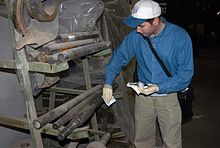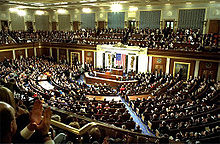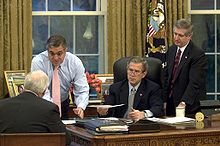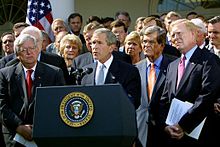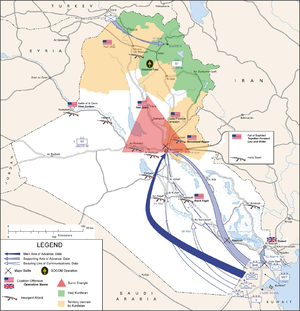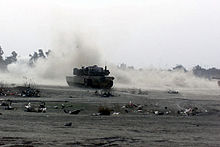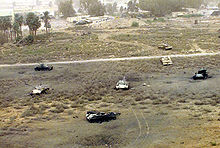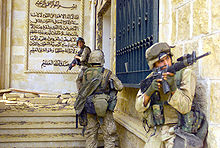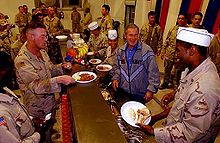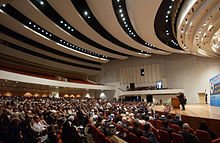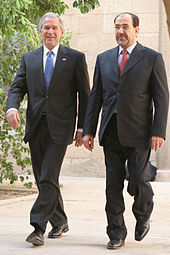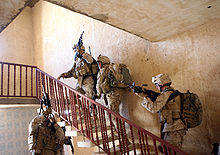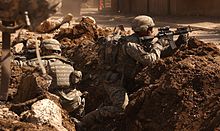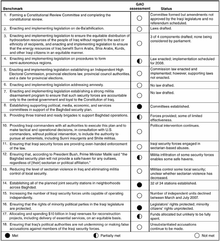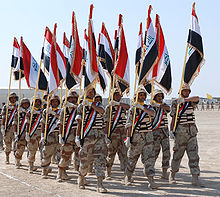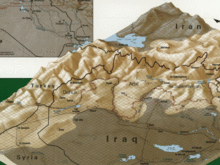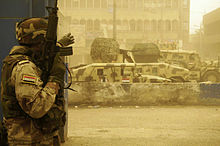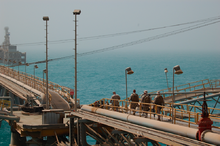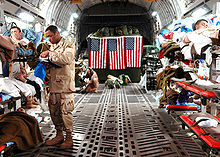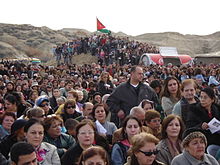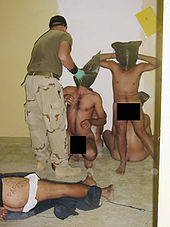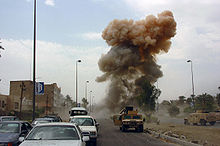- Iraq War
-
This article is about the war that began in 2003. For other uses, see Iraq War (disambiguation).Further information: 2003 invasion of Iraq and Post-invasion Iraq
Iraq War Part of the War on Terror 
Clockwise, starting at top left: a joint patrol in Samarra; the toppling of the Saddam Hussein statue in Firdos Square; an Iraqi Army soldier readies his rifle during an assault; a roadside bomb detonates in South Baghdad.Date March 20, 2003 – present
(8 years, 245 days)[1][2][3][4][5][6]Location Iraq Status Coalition combat operations concluded,[7][8] low level internal conflict ongoing - Invasion and occupation of Iraq
- Overthrow of Baath Party government and execution of Saddam Hussein, election of new government
- Insurgency, foreign terrorist operations, and sectarian violence[9]
- Subsequent depletion of Iraqi insurgency,[10] improvements in public security[11]
- Continued presence of American troops in advise and assist role until the end of 2011
Belligerents  United States
United States
 Iraq
Iraq
 Peshmerga
Peshmerga
 Awakening Councils
Awakening Councils
Withdrawn forces:
 United Kingdom (2003–11)
United Kingdom (2003–11)
 Australia (2003–09)
Australia (2003–09)
 Poland (2003–08)
Poland (2003–08)
 Republic of Korea (2003–08)
Republic of Korea (2003–08)
 Italy (2003–06)
Italy (2003–06)
 Georgia (2003–08)
Georgia (2003–08)
 Ukraine (2003–08)
Ukraine (2003–08)
 Netherlands (2003–05)
Netherlands (2003–05)
 Spain (2003–04)
Spain (2003–04)
 MNF–I (2004–10)
MNF–I (2004–10)
and 30 other countries in the Multi-National ForceInsurgent groups:
 Baath Party Loyalists
Baath Party Loyalists
 Islamic State of Iraq
Islamic State of Iraq
 al-Qaeda in Iraq
al-Qaeda in Iraq
 Mahdi Army
Mahdi Army
Special Groups
Islamic Army of Iraq
Ansar al-Sunnah
For fighting between insurgent groups, see Civil war in Iraq.
Commanders and leaders  George W. Bush
George W. Bush
 Barack Obama
Barack Obama
 Lloyd Austin
Lloyd Austin
 Raymond Odierno
Raymond Odierno
 David Petraeus
David Petraeus
 George W. Casey, Jr.
George W. Casey, Jr.
 Ricardo Sanchez
Ricardo Sanchez
 Tommy Franks
Tommy Franks
 John Cooper
John Cooper
 Andy Salmon
Andy Salmon
 Richard Shirreff
Richard Shirreff
 Jalal Talabani
Jalal Talabani
 Ibrahim al-Jaafari
Ibrahim al-Jaafari
 Nouri al-Maliki
Nouri al-Maliki
 Massoud Barzani
Massoud Barzani
 Masrour Barzani
Masrour Barzani
 Abdul Sattar Abu Risha (KIA)
Abdul Sattar Abu Risha (KIA)
 Ahmad Abu Risha
Ahmad Abu Risha Saddam Hussein
Saddam Hussein
(POW)
 Qusay Hussein (KIA)
Qusay Hussein (KIA)
 Uday Hussein (KIA)
Uday Hussein (KIA)
 Tariq Aziz
Tariq Aziz 
 Izzat Ibrahim ad-Douri
Izzat Ibrahim ad-Douri
 Abu Omar al-Baghdadi (KIA)
Abu Omar al-Baghdadi (KIA)
 Abu Musab al-Zarqawi (KIA)
Abu Musab al-Zarqawi (KIA)
 Abu Ayyub al-Masri (KIA)
Abu Ayyub al-Masri (KIA)
 Abu Suleiman (KIA)
Abu Suleiman (KIA)
 Abu Dua
Abu Dua
 Muqtada al-Sadr
Muqtada al-Sadr
 Abu Deraa
Abu Deraa
Ishmael Jubouri
Abu Abdullah al-Shafi'i (POW)Strength Invasion Forces (2003–2004)
~300,000
United States
39,000 (current)[12]
Iraqi Security Forces
805,269 (military and paramilitary: 578,269,[13] police: 227,000)
Awakening militias
~103,000 (2008)[14]
Iraqi Kurdistan
~400,000 (Kurdish Border Guard: 30,000,[15] Peshmerga 375,000)
Coalition Forces (2004–2011)
176,000 at peak
Security contractors 6,000-7,000 (estimate)[16]
Iraqi Army: 375,000 (disbanded in 2003)
Sunni Insurgents
~70,000 (2007)[17]
Mahdi Army
~60,000 (2007)[18]
al-Qaeda
~1,300 (2006)[19]
Islamic State of Iraq
~1,000 (2008)Casualties and losses Iraqi Security Forces (post-Saddam)
Killed: 16,623[20] Wounded: 40,000+[21]
Coalition Forces
Killed: 4,794[22][23] (4,476 U.S.,[24] 179 UK,[25] 139 other)
Missing/captured (U.S.): 10 (9 rescued)[26]Wounded: 32,629+ (32,102 U.S.,[27] 315 UK, 212+ other[28])[29][30][31][32] Injured/diseased/other medical:** 51,139 (47,541 U.S.,[33] 3,598 UK)[29][31][32]
Contractors
Killed: 1,764*[34][35] Wounded & injured: 59,465*[34][35]
Missing/captured: 16 (U.S. 5)
Awakening Councils
Killed: 1,002+[36]
Wounded: 500+ (2007),[37] 828 (2008)[38]Total dead: 24,418
Total wounded: 73,129Iraqi combatant dead (invasion period): 7,600–10,800[39][40] Insurgents (post-Saddam)
Killed: 21,221–26,405 (2003-2011)[41]
Detainees: 200 (U.S.-held)[42]
12,000 (Iraqi-held)[43]Total dead: 28,736-37,120
Documented civilian deaths from violence, Iraq Body Count – 2003 through October 25, 2011: 103,160–112,726 recorded[44] and 15,114 new deaths added from the Iraq War Logs[45] Estimated excess deaths, (Lancet) – March 2003 - July 2006: 654,965 (95% CI: 392,979-942,636)[46][47]
Estimated violent deaths, Iraq Family Health Survey - March 2003 - July 2006: 151,000 (95% CI: 104,000-223,000)[48]
For more information see: Casualties of the Iraq War
*Casualty numbers from the US Dept. of Labor for Contractors are combined for Iraq and Afghanistan.
** "injured, diseased, or other medical" – required medical air transport. UK number includes "aeromed evacuations"
***Total deaths include all additional deaths due to increased lawlessness, degraded infrastructure, poorer healthcare, etc.The Iraq War (or War in Iraq) began on March 20, 2003[49][50] with the invasion of Iraq by the United States under the administration of President George W. Bush and the United Kingdom under Prime Minister Tony Blair.[51] The war is also referred to as the Occupation of Iraq, the Second Gulf War, or Operation Iraqi Freedom by the US military.
Prior to the invasion, the governments of the United States and the United Kingdom asserted that the possibility of Iraq employing weapons of mass destruction (WMD) threatened their security and that of their coalition/regional allies.[52][53][54] In 2002, the United Nations Security Council passed Resolution 1441 which called for Iraq to completely cooperate with UN weapon inspectors to verify that it was not in possession of weapons of mass destruction and cruise missiles. The United Nations Monitoring, Verification and Inspection Commission (UNMOVIC) was given access by Iraq under provisions of the UN resolution but found no evidence of weapons of mass destruction. Additional months of inspection to conclusively verify Iraq's compliance with the UN disarmament requirements were not undertaken.[55][56][57][58] Head weapons inspector Hans Blix advised the UN Security Council that while Iraq's cooperation was "active", it was not "unconditional" and not "immediate". Iraq's declarations with regards to weapons of mass destruction could not be verified at the time, but unresolved tasks concerning Iraq's disarmament could be completed in "not years, not weeks, but months".[55][59]
Following the invasion, the U.S.-led Iraq Survey Group concluded that Iraq had ended its nuclear, chemical, and biological programs in 1991 and had no active programs at the time of the invasion but that Iraq intended to resume production once sanctions were lifted.[60] Although some degraded remnants of misplaced or abandoned chemical weapons from before 1991 were found, they were not the weapons which had been the main argument to justify the invasion.[61] Some U.S. officials also accused Iraqi President Saddam Hussein of harboring and supporting al-Qaeda,[62] but no evidence of a meaningful connection was ever found.[63][64] Other reasons for the invasion given by the governments of the attacking countries included Iraq's financial support for the families of Palestinian suicide bombers,[65] Iraqi government human rights abuse,[66] and an effort to spread democracy to the country.[67][68]
The invasion of Iraq led to an occupation and the eventual capture of President Saddam, who was later tried in an Iraqi court of law and executed by the new Iraqi government. Violence against coalition forces and among various sectarian groups soon led to the Iraqi insurgency, strife between many Sunni and Shia Iraqi groups, and the emergence of a new faction of al-Qaeda in Iraq.[69][70] In 2008, the UNHCR reported an estimate of 4.7 million refugees (~16% of the population) with 2 million abroad (a number close to CIA projections[71]) and 2.7 million internally displaced people.[72] In 2007, Iraq's anti-corruption board reported that 35% of Iraqi children, or about five million children, were orphans.[73] The Red Cross stated in March 2008 that Iraq's humanitarian situation remained among the most critical in the world, with millions of Iraqis forced to rely on insufficient and poor-quality water sources.[74]
In June 2008, U.S. Department of Defense officials claimed security and economic indicators began to show signs of improvement in what they hailed as significant and fragile gains.[75] In 2007, Iraq was second on the Failed States Index; though its ranking has steadily improved since then, moving to fifth on the 2008 list, sixth in 2009, and seventh in 2010.[76] As public opinion favoring troop withdrawals increased and as Iraqi forces began to take responsibility for security, member nations of the Coalition withdrew their forces.[77][78] In late 2008, the U.S. and Iraqi governments approved a Status of Forces Agreement effective through January 1, 2012.[79] The Iraqi Parliament also ratified a Strategic Framework Agreement with the U.S.,[80] aimed at ensuring cooperation in constitutional rights, threat deterrence, education,[81] energy development, and other areas.[82]
In late February 2009, newly elected U.S. President Barack Obama announced an 18-month withdrawal window for combat forces, with approximately 50,000 troops remaining in the country "to advise and train Iraqi security forces and to provide intelligence and surveillance".[83][84] General Ray Odierno, the top U.S. military commander in Iraq, said he believes all U.S. troops will be out of the country by the end of 2011,[85] while UK forces ended combat operations on April 30, 2009.[86] Iraqi Prime Minister Nouri al-Maliki has said he supports the accelerated pullout of U.S. forces.[87] In a speech at the Oval Office on 31 August 2010 Obama declared "the American combat mission in Iraq has ended. Operation Iraqi Freedom is over, and the Iraqi people now have lead responsibility for the security of their country."[88][89][90] Beginning September 1, 2010, the American operational name for its involvement in Iraq changed from "Operation Iraqi Freedom" to "Operation New Dawn." The remaining 50,000 U.S. troops are now designated as "advise and assist brigades" assigned to non-combat operations while retaining the ability to revert to combat operations as necessary. Two combat aviation brigades also remain in Iraq.[91] According to the Associated Press, however, "combat in Iraq is not over," and "U.S. troops remain involved in combat operations alongside Iraqi forces, although U.S. officials say the American combat mission has formally ended."[92][93]
However on October 21, 2011, President Obama announced that all U.S. troops and trainers would leave Iraq by the end of the year, bringing the U.S. mission in Iraq to an end.[94]
Contents
- 1 2001–2003: Iraq disarmament crisis and pre-war intelligence
- 2 2003: Invasion
- 3 2004: Insurgency expands
- 4 2005: Elections and transitional government
- 5 2006: Civil war and permanent Iraqi government
- 6 2007: U.S. troop surge
- 7 2008: Iraqi forces arm
- 8 2009: Coalition redeployment
- 9 2010: U.S. drawdown and Operation New Dawn
- 10 2011: End Game
- 11 Casualty estimates
- 12 Criticism and cost
- 13 Humanitarian crises
- 14 Human rights abuses
- 15 Public opinion on the war
- 16 Relation to the U.S. Global War on Terrorism
- 17 Iranian involvement
- 18 See also
- 19 References
- 20 Further reading
- 21 External links
2001–2003: Iraq disarmament crisis and pre-war intelligence
See also: Lead up to the Iraq War, Rationale for the Iraq War, Public relations preparations for 2003 invasion of Iraq, Governments' pre-war positions on invasion of Iraq, Saddam Hussein and al-Qaeda, and Iraq and weapons of mass destructionMain articles: Iraq disarmament timeline 1990–2003 and 2002 in IraqUN weapons inspections resume
The issue of Iraq's disarmament reached a crisis in 2002–2003, when Bush demanded a complete end to alleged Iraqi production of weapons of mass destruction and full compliance with UN Security Council Resolutions requiring UN weapons inspectors unfettered access to suspected weapons production facilities. The UN had prohibited Iraq from developing or possessing such weapons after the Gulf War and required Iraq to permit inspections confirming compliance. During inspections in 1999, Iraq alleged that UN inspectors included U.S. intelligence agents that supplied the U.S. with a direct feed of conversations between Iraqi security agencies as well as other information. This was confirmed by the New York Times and the Wall Street Journal.[95]
During 2002, Bush repeatedly warned of military action unless inspections were allowed to progress unfettered. In accordance with UN Security Council Resolution 1441 Iraq reluctantly agreed to new inspections in late 2002. A third weapons inspection team in 2003 led by David Kelly (weapons expert) viewed and photographed with the cooperation of Iraqis two alleged mobile weapons laboratories which were facilities for the production of hydrogen gas to fill balloons.
Shortly before the invasion Hans Blix, the lead weapons inspector, advised the UN Security Council that Iraq was cooperating with inspections and that the confirmation of disarmament through inspections could be achieved in a short period of time if Iraq remained cooperative.[59]
Alleged weapons of mass destruction
Yellowcake uranium
Before the Gulf War, in 1990, Iraq had stockpiled 550 short tons (500 t) of yellowcake uranium at the Tuwaitha nuclear complex about 20 kilometres (12 mi) south of Baghdad.[96] In late February 2002, the CIA sent former Ambassador Joseph Wilson to investigate reports (later found to be forgeries) that Iraq was attempting to purchase additional yellowcake from Niger. Wilson returned and informed the CIA that reports of yellowcake sales to Iraq were "unequivocally wrong." The Bush administration, however, continued to allege Iraq's attempts to obtain additional yellowcake were a justification for military action, most prominently in the January 2003, State of the Union address, in which President Bush declared that Iraq had sought uranium, citing British intelligence sources.[97]
In response, Wilson wrote a critical New York Times op-ed piece in June 2003 stating that he had personally investigated claims of yellowcake purchases and believed them to be fraudulent.[98] After Wilson's op-ed, Wilson's wife Valerie Plame was publicly identified as an undercover CIA analyst by a columnist. This led to a Justice Department investigation into the source of the leak.
On May 1, 2005, the "Downing Street memo" was published in The Sunday Times. It contained an overview of a secret July 23, 2002, meeting among British government, Ministry of Defence, and British intelligence figures who discussed the build-up to the Iraq war—including direct references to classified U.S. policy of the time. The memo stated, "Bush wanted to remove Saddam, through military action, justified by the conjunction of terrorism and WMD. But the intelligence and facts were being fixed around the policy."[99]
In September 2002, the Bush administration, the CIA and the DIA said attempts by Iraq to acquire high-strength aluminum tubes that were prohibited under the UN monitoring program and which they said pointed to a clandestine effort to make centrifuges to enrich uranium for nuclear bombs.[100] This analysis was opposed by the United States Department of Energy (DOE) and INR, which was significant because of DOE's expertise in such gas centrifuges and nuclear weapons programs. The DOE and INR argued that the Iraqi tubes were poorly suited for centrifuges, though it was technically possible with additional modification.[101] A report released by the Institute for Science and International Security in 2002 reported that it was highly unlikely that the tubes could be used to enrich uranium.[102]
An effort by the DOE to correct this detail in comments prepared for United States Secretary of State Colin Powell's UN appearance was rebuffed by the administration[102][103] and Powell, in his address to the UN Security Council just before the war, referenced the aluminum tubes, stating that while experts disagreed on whether or not the tubes were destined for a centrifuge program, the specifications of the tubes were unusually tight.[104] Powell later admitted he had presented what turned out to be an inaccurate case to the UN on Iraqi weapons, and the intelligence he was relying on was, in some cases, "deliberately misleading."[105][106][107] After the United States presidential election, 2008, and the election of Democratic party nominee Barack Obama, president Bush stated that "[my] biggest regret of all the presidency has to have been the intelligence failure in Iraq".[108]
Poison gas
The CIA had contacted Iraq's foreign minister, Naji Sabri, who was being paid by the French as an agent. Sabri informed them that Saddam had hidden poison gas among Sunni tribesmen, had ambitions for a nuclear program but that it was not active, and that no biological weapons were being produced or stockpiled, although research was underway.[109] According to Sidney Blumenthal, George Tenet briefed Bush on September 18, 2002, that Sabri had informed them that Iraq did not have WMD. Bush dismissed this top-secret intelligence from Hussein's inner circle which was approved by two senior CIA officers. The information was never shared with Congress or CIA agents examining whether Saddam had such weapons.[110]
Biological weapons
Based on reports obtained by the German intelligence service from an Iraqi defector codenamed "Curveball", Colin Powell presented evidence to the United Nations security council that Iraq had an active biological weapons programme. On February 15, 2011, the defector—a scientist identified as Rafid Ahmed Alwan al-Janafi—admitted to journalists working for The Guardian newspaper that he lied to the Bundesnachrichtendienst in order to strengthen the case against Saddam Hussein, whom he wished to see removed from power.[111]
Result
In December 2009, former Prime Minister Tony Blair stated that he "would still have thought it right to remove [Saddam Hussein]" regardless of whether Iraq possessed weapons of mass destruction or not.[112]
Preparations for Iraq war
During 2002 the amount of ordnance used by British and American aircraft patrolling the no-fly zones of Iraq increased compared to the previous years[113] and by August had "become a full air offensive". Tommy Franks, the allied commander, later stated that the bombing was designed to "degrade" the Iraqi air defense system before an invasion.[114]
In October 2002, a few days before the U.S. Senate voted on the Joint Resolution to Authorize the Use of United States Armed Forces Against Iraq, about 75 senators were told in closed session that Iraq had the means of attacking the Eastern Seaboard of the U.S. with biological or chemical weapons delivered by unmanned aerial vehicles (UAVs.)[53] On February 5, 2003, Colin Powell presented further evidence in his Iraqi WMD program presentation to the UN Security Council that UAVs were ready to be launched against the U.S. At the time, there was a vigorous dispute within the U.S. military and intelligence communities as to whether CIA conclusions about Iraqi UAVs were accurate[115] and other intelligence agencies suggested that Iraq did not possess any offensive UAV capability, saying the few they had were designed for surveillance and intended for reconnaissance.[116] The Senate voted to approve the Joint Resolution with the support of large bipartisan majorities on October 11, 2002, providing the Bush administration with a legal basis for the U.S. invasion under U.S. law.
The resolution granted the authorization by the Constitution of the United States and the United States Congress for the President to command the military to fight anti-United States violence. Citing the Iraq Liberation Act of 1998, the resolution reiterated that it should be the policy of the United States to remove the Hussein regime and promote a democratic replacement. The authorization was signed by President George W. Bush on October 16, 2002.
Chief UN weapons inspector Hans Blix remarked in January 2003 that "Iraq appears not to have come to a genuine acceptance—not even today—of the disarmament, which was demanded of it and which it needs to carry out to win the confidence of the world and to live in peace."[117] Among other things he noted that 1,000 short tons (910 t) of chemical agent were unaccounted for, information on Iraq's VX nerve agent program was missing, and that "no convincing evidence" was presented for the destruction of 8,500 litres (1,900 imp gal; 2,200 US gal) of anthrax that had been declared.[117]
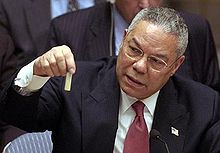 United States Secretary of State Colin Powell holding a model vial of anthrax while giving a presentation to the United Nations Security Council
United States Secretary of State Colin Powell holding a model vial of anthrax while giving a presentation to the United Nations Security Council
In the 2003 State of the Union address, President Bush said "we know that Iraq, in the late 1990s, had several mobile biological weapons labs". On February 5, 2003, Secretary of State Colin Powell appeared before the UN to present American evidence that Iraq was hiding unconventional weapons.[118] The French government also believed that Saddam had stockpiles of anthrax and botulism toxin, and the ability to produce VX.[119] In March, Blix said progress had been made in inspections, and no evidence of WMD had been found.[55] Iraqi scientist Rafid Ahmed Alwan al-Janabi codenamed "Curveball", admitted in February 2011, that he lied to the CIA about biological weapons in order to get the US to attack and remove Hussein from power.[120]
In early 2003, the U.S., British, and Spanish governments proposed the so-called "eighteenth resolution" to give Iraq a deadline for compliance with previous resolutions enforced by the threat of military action. This proposed resolution was subsequently withdrawn due to lack of support on the UN Security Council. In particular, North Atlantic Treaty Organization (NATO) members France, Germany and Canada and non-NATO member Russia were opposed to military intervention in Iraq, due to the high level of risk to the international community's security, and defended disarmament through diplomacy.[121][122]
A meeting between George W. Bush and Tony Blair took place on January 31, 2003, in the White House. A secret memo of this meeting purportedly showed that the Bush administration had already decided on the invasion of Iraq at that point. Bush was allegedly floating the idea of painting a U-2 spyplane in UN colors and letting it fly low over Iraq to provoke Iraqi forces into shooting it down, thereby providing a pretext for the U.S. and Britain to invade. Bush and Blair made a secret deal to carry out the invasion regardless of whether WMD were discovered by UN weapons inspectors, in direct contradiction with statements Blair made to the British House of Commons afterwards that the Iraqi regime would be given a final chance to disarm. In the memo, Bush is paraphrased as saying, "The start date for the military campaign was now pencilled in for 10 March. This was when the bombing would begin." [123] Bush said to Blair that he "thought it unlikely that there would be internecine warfare between the different religious and ethnic groups" in Iraq after the war.
Opposition to invasion
Further information: criticism of the Iraq War, legitimacy of the 2003 invasion of Iraq, and legality of the Iraq WarIn October 2002 former U.S. President Bill Clinton warned about possible dangers of pre-emptive military action against Iraq. Speaking in the UK on a Labour Party conference he said: "As a preemptive action today, however well-justified, may come back with unwelcome consequences in the future....I don't care how precise your bombs and your weapons are, when you set them off, innocent people will die."[124][125]
On January 20, 2003, French Foreign Minister Dominique de Villepin declared "we believe that military intervention would be the worst solution."[126] Meanwhile anti-war groups across the world organised public protests. According to French academic Dominique Reynié, between January 3 and April 12, 2003, 36 million people across the globe took part in almost 3,000 protests against war in Iraq, with demonstrations on February 15, 2003, being the largest and most prolific.[127]
In February 2003, the U.S. Army's top general, Eric Shinseki, told the Senate Armed Services Committee that it would take "several hundred thousand soldiers" to secure Iraq.[128] Two days later, U.S. Defense Secretary Donald Rumsfeld said the post-war troop commitment would be less than the number of troops required to win the war, and that "the idea that it would take several hundred thousand U.S. forces is far from the mark." Deputy Defense Secretary Paul Wolfowitz said Shineski's estimate was "way off the mark," because other countries would take part in an occupying force.[129]
In March 2003, Hans Blix reported that "No evidence of proscribed activities have so far been found" in Iraq, saying that progress was made in inspections which would continue. He estimated the time remaining for disarmament being verified through inspections to be "months".[55] But the U.S. government announced that "diplomacy has failed", and that it would proceed with a coalition of allied countries—named the "coalition of the willing"—to rid Iraq of its alleged WMD. The U.S. government abruptly advised UN weapons inspectors to leave Baghdad immediately.
There were serious legal questions surrounding the launching of the war against Iraq and the Bush Doctrine of preemptive war in general. On September 16, 2004, Kofi Annan, the Secretary General of the United Nations, said of the invasion, "I have indicated it was not in conformity with the UN Charter. From our point of view, from the Charter point of view, it was illegal."
In November 2008 Lord Bingham, the former British Law Lord, described the war a serious violation of international law, and accused Britain and the U.S. of acting like a "world vigilante". He also criticized the post-invasion record of Britain as "an occupying power in Iraq". Regarding the treatment of Iraqi detainees in Abu Ghraib, Bingham said: "Particularly disturbing to proponents of the rule of law is the cynical lack of concern for international legality among some top officials in the Bush administration."[130] In July 2010, Deputy Prime Minister of the UK Nick Clegg, in an official PMQs session in Parliament, condemned the invasion of Iraq as illegal.[131] Theorist Francis Fukuyama has argued that "the Iraq war and the close association it created between military invasion and democracy promotion tarnished the latter".[132]
2003: Invasion
Main articles: 2003 invasion of Iraq, 2003 in Iraq, 2003 Iraq war timeline, and List of people associated with the 2003 invasion of IraqSee also: Coalition military operations of the Iraq War and Iraq War order of battleM1 Abrams tank fires its 120mm cannon at Iraqi forces during fighting in Al-Faw peninsula near Umm Qasr, 23 March 2003.
The first Central Intelligence Agency invasion team entered Iraq on July 10, 2002.[133] This team was composed of members of the CIA's Special Activities Division and was later joined by members of the U.S. military's elite Joint Special Operations Command (JSOC).[134] Together, they prepared for the invasion of conventional forces. These efforts consisted of persuading the commanders of several Iraqi military divisions to surrender rather than oppose the invasion, and to identify all of the initial leadership targets during very high risk reconnaissance missions.[134]
Most importantly, their efforts organized the Kurdish Peshmerga to become the northern front of the invasion. Together this force defeated Ansar al-Islam in Iraqi Kurdistan before the invasion and then defeated the Iraqi army in the north.[134][135] The battle against Ansar al-Islam led to the death of a substantial number of militants and the uncovering of a chemical weapons facility at Sargat.[133][136]
At 5:34 a.m. Baghdad time on March 20, 2003 (9:34 p.m., March 19 EST) the military invasion of Iraq began.[137] The 2003 invasion of Iraq, led by U.S. army General Tommy Franks, began under the codename "Operation Iraqi Liberation",[138] later renamed "Operation Iraqi Freedom", the UK codename Operation Telic, and the Australian codename Operation Falconer. Coalition forces also cooperated with Kurdish Peshmerga forces in the north. Approximately forty other governments, the "U.S.-led coalition against Iraq," participated by providing troops, equipment, services, security, and special forces, with 248,000 soldiers from the United States, 45,000 British soldiers, 2,000 Australian soldiers and 194 Polish soldiers from Special Forces unit GROM sent to Kuwait for the invasion.[139] The invasion force was also supported by Iraqi Kurdish militia troops, estimated to number upwards of 70,000.[140]
The stated objectives of the invasion were; end the Hussein regime; eliminate whatever weapons of mass destruction could be found; eliminate whatever Islamist militants could be found; obtain intelligence on militant networks; distribute humanitarian aid; secure Iraq's petroleum infrastructure; and assist in creating a representative but compliant government as a model for other Middle East nations.
The invasion was a quick and decisive operation encountering major resistance, though not what the U.S., British and other forces expected. The Iraqi regime had prepared to fight both a conventional and irregular war at the same time, conceding territory when faced with superior conventional forces, largely armored, but launching smaller scale attacks in the rear using fighters dressed in civilian and paramilitary clothes. This achieved some temporary successes and created unexpected challenges for the invading forces, especially the U.S. military.
Coalition troops launched air and amphibious assault on the Al-Faw peninsula to secure the oil fields there and the important ports, supported by warships of the Royal Navy, Polish Navy, and Royal Australian Navy. The United States Marine Corps' 15th Marine Expeditionary Unit, attached to 3 Commando Brigade and the Polish Special Forces unit GROM attacked the port of Umm Qasr, while the British Army's 16 Air Assault Brigade secured the oilfields in southern Iraq. Polish commandos captured offshore oil platforms near the port, preventing their destruction.
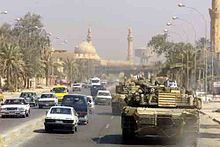 A Marine Corps M1 Abrams tank patrols a Baghdad street after its fall in 2003 during Operation Iraqi Freedom.
A Marine Corps M1 Abrams tank patrols a Baghdad street after its fall in 2003 during Operation Iraqi Freedom.
The heavy armor of the U.S. 3rd Infantry Division moved westward and then northward through the western desert toward Baghdad, while the 1st Marine Expeditionary Force moved more easterly along Highway 1 through the center of the country, and 1 (UK) Armoured Division moved northward through the eastern marshland. The U.S. 1st Marine Division fought through Nasiriyah in a battle to seize the major road junction and nearby Talil Airfield. The United States Army 3rd Infantry Division defeated Iraqi forces entrenched in and around the airfield and bypassed the city to the west in its drive up north through western Iraq.
With the Nasiriyah and Talil Airfields secured in its rear, the 3rd Infantry Division supported by 101st Airborne Division continued its attack north toward Najaf and Karbala, but a severe sand storm slowed the coalition advance and there was a halt to consolidate and make sure the supply lines were secure. When they started again they secured the Karbala Gap, a key approach to Baghdad, then secured the bridges over the Euphrates River, and the American forces poured through the gap on to Baghdad. In the middle of Iraq, the 1st Marine Division fought its way to the eastern side of Baghdad, and prepared for the attack into Badhdad to seize it.[141]
In the north, OIF-1 used the largest special operations force since the successful attack on the Taliban government of Afghanistan just over a year earlier. The Iraqi army was quickly overwhelmed in each engagement it faced with U.S. forces, with the elite Fedayeen Saddam putting up strong, sometimes suicidal, resistance before melting away into the civilian population.
On April 9 Baghdad fell, ending President Hussein's 24-year rule. U.S. forces seized the deserted Ba'ath Party ministries and stage-managed[142] the tearing down of a huge iron statue of Hussein, photos and video of which became symbolic of the event, although later controversial. Not seen in the photos or heard on the videos, shot with a zoom lens, was the chant of the inflamed crowd for al-Sadr, the radical Shiite cleric.[143] In November 2008, Iraqi protesters staged a similar stomping on and burning of an effigy of George W. Bush.[144] The abrupt fall of Baghdad was accompanied by a widespread outpouring of gratitude toward the invaders, but also massive civil disorder, including the looting of public and government buildings and drastically increased crime.[145][146]
According to the Pentagon, 250,000 short tons (230,000 t) (of 650,000 short tons (590,000 t) total) of ordnance was looted, providing a significant source of ammunition for the Iraqi insurgency. The invasion phase concluded when Tikrit, Hussein's home town, fell with little resistance to the U.S. Marines of Task Force Tripoli and on April 15 the coalition declared the invasion effectively over.
In the invasion phase of the war (March 19-April 30), 9,200 Iraqi combatants were killed along with 7,299 civilians, primarily by U.S. air and ground forces.[147] Coalition forces reported the death in combat of 139 U.S. military personnel[148] and 33 UK military personnel.[149]
Coalition Provisional Authority and Iraq Survey Group
See also: Iraqi Governing Council, International Advisory and Monitoring Board, CPA Program Review Board, Development Fund for Iraq, and Reconstruction of Iraq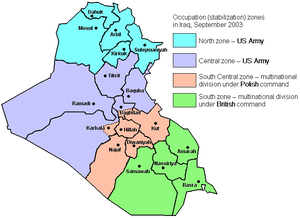 Occupation zones in Iraq as of September 2003.
Occupation zones in Iraq as of September 2003.
Shortly after the invasion, which has resulted in the debellatio of Iraq, the multinational coalition created the Coalition Provisional Authority (CPA) سلطة الائتلاف الموحدة, based in the Green Zone, as a transitional government of Iraq until the establishment of a democratic government. Citing United Nations Security Council Resolution 1483 (May 22, 2003) and the laws of war, the CPA vested itself with executive, legislative, and judicial authority over the Iraqi government from the period of the CPA's inception on April 21, 2003, until its dissolution on June 28, 2004.
The CPA was originally headed by Jay Garner, a former U.S. military officer, but his appointment lasted only until May 11, 2003, when President Bush appointed L. Paul Bremer. Bremer served until the CPA's dissolution in July 2004.
Another group created by the multinational force in Iraq post-invasion was the 1,400-member international Iraq Survey Group who conducted a fact-finding mission to find Iraqi weapons of mass destruction (WMD) programmes. In 2004 the ISG's Duelfer Report[150] stated that Iraq did not have a viable WMD program.
Post-invasion phase
Main article: Post-invasion Iraq, 2003–presentFurther information: U.S. list of most-wanted Iraqis and Iraq War insurgent attacksOn May 1, 2003, President Bush staged a dramatic visit to the aircraft carrier USS Abraham Lincoln operating a few miles west of San Diego, California. The visit climaxed at sunset with Bush's now well-known "Mission Accomplished" speech. In this nationally televised speech, delivered before the sailors and airmen on the flight deck, Bush effectively declared victory due to the defeat of Iraq's conventional forces. However, Saddam remained at large and significant pockets of resistance remained.
After President Bush's speech, coalition forces noticed a gradually increasing flurry of attacks on its troops in various regions, especially in the "Sunni Triangle".[151] The initial Iraqi insurgents were supplied by hundreds of weapons caches created before the invasion by the Iraqi army and Republican Guard.
Initially, Iraqi resistance (described by the coalition as "Anti-Iraqi Forces") largely stemmed from fedayeen and Hussein/Ba'ath Party loyalists, but soon religious radicals and Iraqis angered by the occupation contributed to the insurgency. The three provinces with the highest number of attacks were Baghdad, Al Anbar, and Salah Ad Din. Those three provinces account for 35% of the population, but as of December 5, 2006 were responsible for 73% of U.S. military deaths and an even higher percentage of recent U.S. military deaths (about 80%.)[152]
Insurgents used guerrilla tactics including: mortars, missiles, suicide attacks, snipers, improvised explosive devices (IEDs), car bombs, small arms fire (usually with assault rifles), and RPGs (rocket propelled grenades), as well as sabotage against the petroleum, water, and electrical infrastructure.
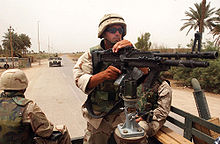 Seabees of NMCB-15 (Naval Mobile Construction Battalion), on a convoy in Iraq in May 2003
Seabees of NMCB-15 (Naval Mobile Construction Battalion), on a convoy in Iraq in May 2003
Post-invasion Iraq coalition efforts commenced after the fall of the Hussein regime. The coalition nations, together with the United Nations, began to work to establish a stable, compliant democratic state capable of defending itself from non-coalition forces, as well as overcoming internal divisions.[153][154]
Meanwhile, coalition military forces launched several operations around the Tigris River peninsula and in the Sunni Triangle. A series of similar operations were launched throughout the summer in the Sunni Triangle. Toward the end of 2003, the intensity and pace of insurgent attacks began to increase. A sharp surge in guerrilla attacks ushered in an insurgent effort that was termed the "Ramadan Offensive", as it coincided with the beginning of the Muslim holy month of Ramadan.
To counter this offensive, coalition forces begin to use air power and artillery again for the first time since the end of the invasion by striking suspected ambush sites and mortar launching positions. Surveillance of major routes, patrols, and raids on suspected insurgents were stepped up. In addition, two villages, including Hussein's birthplace of al-Auja and the small town of Abu Hishma were surrounded by barbed wire and carefully monitored.
Capturing former government leaders
See also: Supreme Iraqi Criminal Tribunal and Trial of Saddam HusseinIn the summer of 2003, the multinational forces focused on capturing the remaining leaders of the former government. On July 22, a raid by the U.S. 101st Airborne Division and soldiers from Task Force 20 killed Hussein's sons (Uday and Qusay) along with one of his grandsons. In all, over 300 top leaders of the former government were killed or captured, as well as numerous lesser functionaries and military personnel.
Most significantly, Saddam Hussein himself was captured on December 13, 2003, on a farm near Tikrit in Operation Red Dawn.[155] The operation was conducted by the United States Army's 4th Infantry Division and members of Task Force 121. Intelligence on Saddam's whereabouts came from his family members and former bodyguards.[156]
With the capture of Hussein and a drop in the number of insurgent attacks, some concluded the multinational forces were prevailing in the fight against the insurgency. The provisional government began training the new Iraqi security forces intended to police the country, and the United States promised over $20 billion in reconstruction money in the form of credit against Iraq's future oil revenues. Oil revenue was also used for rebuilding schools and for work on the electrical and refining infrastructure.
Shortly after the capture of Hussein, elements left out of the Coalition Provisional Authority began to agitate for elections and the formation of an Iraqi Interim Government. Most prominent among these was the Shia cleric Grand Ayatollah Ali al-Sistani. The Coalition Provisional Authority opposed allowing democratic elections at this time.[157] The insurgents stepped up their activities. The two most turbulent centers were the area around Fallujah and the poor Shia sections of cities from Baghdad (Sadr City) to Basra in the south.
-
Polish GROM forces in sea operations during Operation Iraqi Freedom.
-
May 18, 2004: Staff Sgt. Kevin Jessen checks the underside of two anti-tank mines found in a village outside Ad Dujayl in the Sunni Triangle.
-
Delta Force of Task Force 20 alongside troops of 3rd Battalion, 327th Infantry Regiment, at Uday Hussain and Qusay Hussein's hideout.
-
Saddam Hussein being pulled from his hideaway in Operation Red Dawn, 13 December 2003.
2004: Insurgency expands
Main article: 2004 in Iraq- See also: Military operations of the Iraq War for a list of all Coalition operations for this period, 2004 in Iraq, Iraqi coalition counter-insurgency operations, History of Iraqi insurgency, United States occupation of Fallujah, Iraq Spring Fighting of 2004
Footage from the gun camera of a U.S. Apache helicopter killing Iraqi Insurgents.[158]
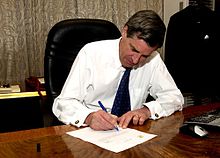 Coalition Provisional Authority director L. Paul Bremer signs over sovereignty to the appointed Iraqi Interim Government, June 28, 2004.
Coalition Provisional Authority director L. Paul Bremer signs over sovereignty to the appointed Iraqi Interim Government, June 28, 2004.
The start of 2004 was marked by a relative lull in violence. Insurgent forces reorganised during this time, studying the multinational forces' tactics and planning a renewed offensive. However, violence did increase during the Iraq Spring Fighting of 2004 with foreign fighters from around the Middle East as well as al-Qaeda in Iraq (an affiliated al-Qaeda group), led by Abu Musab al-Zarqawi helping to drive the insurgency.
As the insurgency grew there was a distinct change in targeting from the coalition forces towards the new Iraqi Security Forces, as hundreds of Iraqi civilians and police were killed over the next few months in a series of massive bombings. An organized Sunni insurgency, with deep roots and both nationalist and Islamist motivations, was becoming more powerful throughout Iraq. The Shia Mahdi Army also began launching attacks on coalition targets in an attempt to seize control from Iraqi security forces. The southern and central portions of Iraq were beginning to erupt in urban guerrilla combat as multinational forces attempted to keep control and prepared for a counteroffensive.
The most serious fighting of the war so far began on March 31, 2004, when Iraqi insurgents in Fallujah ambushed a Blackwater USA convoy led by four U.S. private military contractors who were providing security for food caterers Eurest Support Services.[159] The four armed contractors, Scott Helvenston, Jerko Zovko, Wesley Batalona, and Michael Teague, were killed with grenades and small arms fire. Subsequently, their bodies were dragged from their vehicles by local people, beaten, set ablaze, and their burned corpses hung over a bridge crossing the Euphrates.[160] Photos of the event were released to news agencies worldwide, causing a great deal of indignation and moral outrage in the United States, and prompting an unsuccessful "pacification" of the city: the First Battle of Fallujah in April 2004.
 US Marines fight in the city of Fallujah during Operation Phantom Fury/Operation Al Fajr (New Dawn) in November 2004.
US Marines fight in the city of Fallujah during Operation Phantom Fury/Operation Al Fajr (New Dawn) in November 2004.
The offensive was resumed in November 2004 in the bloodiest battle of the war so far: the Second Battle of Fallujah, described by the U.S. military as "the heaviest urban combat (that they had been involved in) since the battle of Hue City in Vietnam."[161] During the assault, U.S. forces used white phosphorus as an incendiary weapon against insurgent personnel, attracting controversy. The 46-day battle resulted in a victory for the coalition, with 95 U.S. soldiers killed along with approximately 1,350 insurgents. Fallujah was totally devastated during the fighting, though civilian casualties were low, as they had mostly fled before the battle.[162]
Another major event of that year was the revelation of widespread prisoner abuse at Abu Ghraib which received international media attention in April 2004. First reports of the Abu Ghraib prisoner abuse, as well as graphic pictures showing U.S. military personnel taunting and abusing Iraqi prisoners, came to public attention from a 60 Minutes II news report (April 28) and a Seymour M. Hersh article in The New Yorker (posted online on April 30.)[163] Military correspondent Thomas Ricks claimed that these revelations dealt a blow to the moral justifications for the occupation in the eyes of many people, especially Iraqis, and was a turning point in the war.[164]
2005: Elections and transitional government
Further information: 2005 in Iraq and Military transition teamOn January 31, Iraqis elected the Iraqi Transitional Government in order to draft a permanent constitution. Although some violence and a widespread Sunni boycott marred the event, most of the eligible Kurd and Shia populace participated. On February 4, Paul Wolfowitz announced that 15,000 U.S. troops whose tours of duty had been extended in order to provide election security would be pulled out of Iraq by the next month.[165] February to April proved to be relatively peaceful months compared to the carnage of November and January, with insurgent attacks averaging 30 a day from the prior average of 70.
Hopes for a quick end to the insurgency and a withdrawal of U.S. troops were dashed in May, Iraq's bloodiest month since the invasion. Suicide bombers, believed to be mainly disheartened Iraqi Sunni Arabs, Syrians and Saudis, tore through Iraq. Their targets were often Shia gatherings or civilian concentrations of Shias. As a result, over 700 Iraqi civilians died in that month, as well as 79 U.S. soldiers.
The summer of 2005 saw fighting around Baghdad and at Tall Afar in northwestern Iraq as U.S. forces tried to seal off the Syrian border. This led to fighting in the autumn in the small towns of the Euphrates valley between the capital and that border.[166]
A referendum was held on October 15 in which the new Iraqi constitution was ratified. An Iraqi national assembly was elected in December, with participation from the Sunnis as well as the Kurds and Shia.[166]
Insurgent attacks increased in 2005 with 34,131 recorded incidents, compared to a total 26,496 for the previous year.[167]
2006: Civil war and permanent Iraqi government
Further information: 2006 in Iraq, Civil war in Iraq, Operation Together Forward, and Provincial Reconstruction TeamThe beginning of 2006 was marked by government creation talks, growing sectarian violence, and continuous anti-coalition attacks. Sectarian violence expanded to a new level of intensity following the al-Askari Mosque bombing in the Iraqi city of Samarra, on February 22, 2006. The explosion at the mosque, one of the holiest sites in Shi'a Islam, is believed to have been caused by a bomb planted by al-Qaeda.
Although no injuries occurred in the blast, the mosque was severely damaged and the bombing resulted in violence over the following days. Over 100 dead bodies with bullet holes were found on February 23, and at least 165 people are thought to have been killed. In the aftermath of this attack the U.S. military calculated that the average homicide rate in Baghdad tripled from 11 to 33 deaths per day. In 2006 the UN described the environment in Iraq as a "civil war-like situation."[168]
On March 6, five United States Army soldiers of the 502nd Infantry Regiment, raped the 14-year-old Iraqi girl Abeer Hamza al-Janabi, and then murdered her, her father, her mother Fakhriya Taha Muhasen and her six-year-old sister. The soldiers then set fire to the girls body to conceal evidence of the crime.[169] Four of the soldiers were convicted of rape and murder and the fifth was convicted of lesser crimes for the involvement in the war crime, that became known as the Mahmudiyah killings.[170][171]
On June 6, 2006 The US was successful in tracking Abu Musab al-Zarqawi, the leader of al-Qaeda in Iraq who was killed in a targeted killing, while attending a meeting in an isolated safehouse approximately 8 km (5.0 mi) north of Baqubah. At 14:15 GMT two United States Air Force F-16C jets identified the house and the lead jet dropped two 500-pound (230 kg) guided bombs, a laser-guided GBU-12 and GPS-guided GBU-38 on the building where he was located at. Six others—three male and three female individuals—were also reported killed. Among those killed were one of his wives and their child.
The current government of Iraq took office on May 20, 2006, following approval by the members of the Iraqi National Assembly. This followed the general election in December 2005. The government succeeded the Iraqi Transitional Government which had continued in office in a caretaker capacity until the formation of the permanent government.
Iraq Study Group report and Hussein's execution
Main articles: Iraq Study Group and Execution of Saddam Hussein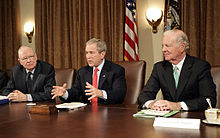 Lee H. Hamilton (left) and James Baker (right) presented the Iraq Study Group Report to George W. Bush on December 6, 2006.
Lee H. Hamilton (left) and James Baker (right) presented the Iraq Study Group Report to George W. Bush on December 6, 2006.
The Iraq Study Group Report was released on December 6, 2006. Iraq Study Group, made up of people from both of the major U.S. parties, was led by co-chairs James Baker, a former Secretary of State (Republican), and Lee H. Hamilton, a former U.S. Representative (Democrat). It concluded that "the situation in Iraq is grave and deteriorating" and "U.S. forces seem to be caught in a mission that has no foreseeable end." The report's 79 recommendations include increasing diplomatic measures with Iran and Syria and intensifying efforts to train Iraqi troops. On December 18, a Pentagon report found that insurgent attacks were averaging about 960 a week, the highest since the reports had begun in 2005.[172]
Coalition forces formally transferred control of a province to the Iraqi government, the first since the war. Military prosecutors charged eight U.S. Marines with the murders of 24 Iraqi civilians in Haditha in November 2005, 10 of them women and children. Four officers were also charged with dereliction of duty in relation to the event.[173]
Saddam Hussein was hanged on December 30, 2006, after being found guilty of crimes against humanity by an Iraqi court after a year-long trial.[174]
2007: U.S. troop surge
In a January 10, 2007, televised address to the U.S. public, Bush proposed 21,500 more troops for Iraq, a job program for Iraqis, more reconstruction proposals, and $1.2 billion for these programs.[175] On January 23, 2007, in the 2007 State of the Union Address, Bush announced "deploying reinforcements of more than 20,000 additional soldiers and Marines to Iraq."
 President George W. Bush visiting US troops in Iraq, September 2007.
President George W. Bush visiting US troops in Iraq, September 2007.
On February 10, 2007, David Petraeus was made commander of Multi-National Force – Iraq (MNF-I), the four-star post that oversees all coalition forces in country, replacing General George Casey. In his new position, Petraeus oversaw all coalition forces in Iraq and employed them in the new "Surge" strategy outlined by the Bush administration.[176][177] 2007 also saw a sharp increase in insurgent chlorine bombings.
On May 10, 2007, 144 Iraqi Parliamentary lawmakers signed onto a legislative petition calling on the United States to set a timetable for withdrawal.[178] On June 3, 2007, the Iraqi Parliament voted 85 to 59 to require the Iraqi government to consult with Parliament before requesting additional extensions of the UN Security Council Mandate for Coalition operations in Iraq.[179] Despite this, the mandate was renewed on December 18, 2007, without the approval of the Iraqi parliament.[180]
Pressures on U.S. troops were compounded by the continuing withdrawal of coalition forces. In early 2007, British Prime Minister Blair announced that following Operation Sinbad British troops would begin to withdraw from Basra Governorate, handing security over to the Iraqis.[181] In July Danish Prime Minister Anders Fogh Rasmussen also announced the withdrawal of 441 Danish troops from Iraq, leaving only a unit of nine soldiers manning four observational helicopters.[182]
Planned troop reduction
In a speech made to Congress on September 10, 2007, Petraeus "envisioned the withdrawal of roughly 30,000 U.S. troops by next summer, beginning with a Marine contingent [in September]."[183] On September 14, Bush backed a limited withdrawal of troops from Iraq.[184] Bush said 5,700 personnel would be home by Christmas 2007, and expected thousands more to return by July 2008. The plan would take troop numbers back to their level before the surge at the beginning of 2007.
Effects of the surge on security
By March 2008, violence in Iraq was reported curtailed by 40–80%, according to a Pentagon report.[185] Independent reports[186][187] raised questions about those assessments. An Iraqi military spokesman claimed that civilian deaths since the start of the troop surge plan were 265 in Baghdad, down from 1,440 in the four previous weeks. The New York Times counted more than 450 Iraqi civilians killed during the same 28-day period, based on initial daily reports from Iraqi Interior Ministry and hospital officials.
Historically, the daily counts tallied by the NYT have underestimated the total death toll by 50% or more when compared to studies by the United Nations, which rely upon figures from the Iraqi Health Ministry and morgue figures.[188]
The rate of U.S. combat deaths in Baghdad nearly doubled to 3.14 per day in the first seven weeks of the "surge" in security activity, compared to previous period. Across the rest of Iraq it reduced slightly.[189][190]
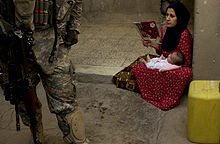 An Iraqi woman looks on as U.S. soldiers search the courtyard of her house in Ameriyah, Iraq. Searching houses for weapons is a common counter-insurgency technique used in Iraq.
An Iraqi woman looks on as U.S. soldiers search the courtyard of her house in Ameriyah, Iraq. Searching houses for weapons is a common counter-insurgency technique used in Iraq.
On August 14, 2007, the deadliest single attack of the whole war occurred. Nearly 800 civilians were killed by a series of coordinated suicide bomb attacks on the northern Iraqi settlement of Qahtaniya. More than 100 homes and shops were destroyed in the blasts. U.S. officials blamed al-Qaeda. The targeted villagers belonged to the non-Muslim Yazidi ethnic minority. The attack may have represented the latest in a feud that erupted earlier that year when members of the Yazidi community stoned to death a teenage girl called Du'a Khalil Aswad accused of dating a Sunni Arab man and converting to Islam. The killing of the girl was recorded on camera-mobiles and the video was uploaded onto the internet[191][192][193][194]
On September 13, 2007, Abdul Sattar Abu Risha was killed in a bomb attack in the city of Ramadi.[195] He was an important U.S. ally because he led the "Anbar Awakening", an alliance of Sunni Arab tribes that opposed al-Qaeda. The latter organisation claimed responsibility for the attack.[196] A statement posted on the Internet by the shadowy Islamic State of Iraq called Abu Risha "one of the dogs of Bush" and described Thursday's killing as a "heroic operation that took over a month to prepare".[197]
There was a reported trend of decreasing U.S. troop deaths after May 2007,[198] and violence against coalition troops had fallen to the "lowest levels since the first year of the American invasion".[199] These, and several other positive developments, were attributed to the surge by many analysts.[200]
Data from the Pentagon and other U.S. agencies such as the Government Accountability Office (GAO) found that daily attacks against civilians in Iraq remained "about the same" since February. The GAO also stated that there was no discernible trend in sectarian violence.[201] However, this report ran counter to reports to Congress, which showed a general downward trend in civilian deaths and ethno-sectarian violence since December 2006.[202] By late 2007, as the U.S. troop surge began to wind down, violence in Iraq had begun to decrease from its 2006 highs.[203]
Entire neighborhoods in Baghdad were ethnically cleansed by Shia and Sunni militias and sectarian violence has broken out in every Iraqi city where there is a mixed population.[204][205][206] Investigative reporter Bob Woodward cites U.S. government sources according to which the U.S. "surge" was not the primary reason for the drop in violence in 2007–2008. Instead, according to that view, the reduction of violence was due to newer covert techniques by U.S. military and intelligence officials to find, target and kill insurgents, including working closely with former insurgents.[207]
In the Shia region near Basra, British forces turned over security for the region to Iraqi Security Forces. Basra is the ninth province of Iraq's 18 provinces to be returned to local security forces' control since the beginning of the occupation.[208]
Political developments
More than half of the members of Iraq's parliament rejected the continuing occupation of their country for the first time. 144 of the 275 lawmakers signed onto a legislative petition that would require the Iraqi government to seek approval from Parliament before it requests an extension of the UN mandate for foreign forces to be in Iraq, which expires at the end of 2008. It also calls for a timetable for troop withdrawal and a freeze on the size of foreign forces. The UN Security Council mandate for U.S.-led forces in Iraq will terminate "if requested by the government of Iraq."[209] Under Iraqi law, the speaker must present a resolution called for by a majority of lawmakers.[210] 59% of those polled in the U.S. support a timetable for withdrawal.[211]
In mid-2007, the Coalition began a controversial program to recruit Iraqi Sunnis (often former insurgents) for the formation of "Guardian" militias. These Guardian militias are intended to support and secure various Sunni neighborhoods against the Islamists.[212]
Tensions with Iran
Further information: United States-Iran relations and Karbala provincial headquarters raidIn 2007, tensions increased greatly between Iran and Iraqi Kurdistan due to the latter's giving sanctuary to the militant Kurdish secessionist group Party for a Free Life in Kurdistan (PEJAK.) According to reports, Iran had been shelling PEJAK positions in Iraqi Kurdistan since August 16. These tensions further increased with an alleged border incursion on August 23 by Iranian troops who attacked several Kurdish villages killing an unknown number of civilians and militants.[213]
Coalition forces also began to target alleged Iranian Quds force operatives in Iraq, either arresting or killing suspected members. The Bush administration and coalition leaders began to publicly state that Iran was supplying weapons, particularly EFP devices, to Iraqi insurgents and militias although to date have failed to provide any proof for these allegations. Further sanctions on Iranian organizations were also announced by the Bush administration in the autumn of 2007. On November 21, 2007, Lieutenant General James Dubik, who is in charge of training Iraqi security forces, praised Iran for its "contribution to the reduction of violence" in Iraq by upholding its pledge to stop the flow of weapons, explosives and training of extremists in Iraq.[214]
Tensions with Turkey
Further information: 2008 Turkish incursion into northern IraqBorder incursions by PKK militants based in Northern Iraq have continued to harass Turkish forces, with casualties on both sides. In the fall of 2007, the Turkish military stated their right to cross the Iraqi Kurdistan border in "hot pursuit" of PKK militants and began shelling Kurdish areas in Iraq and attacking PKK bases in the Mount Cudi region with aircraft.[215][216] The Turkish parliament approved a resolution permitting the military to pursue the PKK in Iraqi Kurdistan.[217] In November, Turkish gunships attacked parts of northern Iraq in the first such attack by Turkish aircraft since the border tensions escalated.[218] Another series of attacks in mid-December hit PKK targets in the Qandil, Zap, Avashin and Hakurk regions. The latest series of attacks involved at least 50 aircraft and artillery and Kurdish officials reported one civilian killed and two wounded.[219]
Additionally, weapons that were given to Iraqi security forces by the U.S. military are being recovered by authorities in Turkey after being used by PKK in that state.[220]
Private security firm controversy
Main article: Blackwater Baghdad shootingsOn September 17, 2007, the Iraqi government announced that it was revoking the license of the U.S. security firm Blackwater USA over the firm's involvement in the killing of eight civilians, including a woman and an infant,[221] in a firefight that followed a car bomb explosion near a State Department motorcade.
2008: Iraqi forces arm
Further information: 2008 in IraqThroughout 2008, U.S. officials and independent think tanks began to point to improvements in the security situation, as measured by key statistics. According to the U.S. Defense Department, in December 2008 the "overall level of violence" in the country had dropped 80% since before the surge began in January 2007, and the country's murder rate had dropped to pre-war levels. They also pointed out that the casualty figure for U.S. forces in 2008 was 314 against a figure of 904 in 2007.[222]
According to the Brookings Institution, Iraqi civilian fatalities numbered 490 in November 2008 as against 3,500 in January 2007, whereas attacks against the coalition numbered somewhere between 200 and 300 per week in the latter half of 2008, as opposed to a peak of nearly 1,600 in summer 2007. The number of Iraqi security forces killed was under 100 per month in the second half of 2008, from a high of 200 to 300 in summer 2007.[223]
Meanwhile, the proficiency of the Iraqi military increased as it launched a spring offensive against Shia militias which Prime Minister Nouri al-Maliki had previously been criticized for allowing to operate. This began with a March operation against the Mehdi Army in Basra, which led to fighting in Shia areas up and down the country, especially in the Sadr City district of Baghdad. By October, the British officer in charge of Basra said that since the operation the town had become "secure" and had a murder rate comparable to Manchester in England.[224] The U.S. military also said there had been a decrease of about a quarter in the quantity of Iranian-made explosives found in Iraq in 2008, possibly indicating a change in Iranian policy.[225]
Progress in Sunni areas continued after members of the Awakening movement were transferred from U.S. military to Iraqi control.[226] In May, the Iraqi army – backed by coalition support – launched an offensive in Mosul, the last major Iraqi stronghold of al-Qaeda. Despite detaining thousands of individuals, the offensive failed to lead to major long-term security improvements in Mosul. At the end of the year, the city remained a major flashpoint.[227][228]
In the regional dimension, the ongoing conflict between Turkey and PKK[229][230][231] intensified on February 21, when Turkey launched a ground attack into the Quandeel Mountains of Northern Iraq. In the nine day long operation, around 10,000 Turkish troops advanced up to 25 km into Northern Iraq. This was the first substantial ground incursion by Turkish forces since 1995.[232][233]
Shortly after the incursion began, both the Iraqi cabinet and the Kurdistan regional government condemned Turkey's actions and called for the immediate withdrawal of Turkish troops from the region.[234] Turkish troops withdrew on February 29.[235] The fate of the Kurds and the future of the ethnically diverse city of Kirkuk remained a contentious issue in Iraqi politics.
U.S. military officials met these trends with cautious optimism as they approached what they described as the "transition" embodied in the U.S.-Iraq Status of Forces Agreement which was negotiated throughout 2008.[222] The commander of the coalition, U.S. General Raymond T. Odierno, noted that "in military terms, transitions are the most dangerous time" in December 2008.[222]
Spring offensives on Shia militias
At the end of March, the Iraqi Army, with Coalition air support, launched an offensive, dubbed "Charge of the Knights", in Basra to secure the area from militias. This was the first major operation where the Iraqi Army did not have direct combat support from conventional coalition ground troops. The offensive was opposed by the Mahdi Army, one of the militias, which controlled much of the region.[236][237] Fighting quickly spread to other parts of Iraq: including Sadr City, Al Kut, Al Hillah and others. During the fighting Iraqi forces met stiff resistance from militiamen in Basra to the point that the Iraqi military offensive slowed to a crawl, with the high attrition rates finally forcing the Sadrists to the negotiating table.
Following talks with Brig. Gen. Qassem Suleimani, commander of the Qods brigades of Iran's Revolutionary Guard Corps, and the intercession of the Iranian government, on March 31, 2008, al-Sadr ordered his followers to ceasefire.[238] The militiamen kept their weapons.
By May 12, 2008, Basra "residents overwhelmingly reported a substantial improvement in their everyday lives" according to The New York Times. "Government forces have now taken over Islamic militants' headquarters and halted the death squads and 'vice enforcers' who attacked women, Christians, musicians, alcohol sellers and anyone suspected of collaborating with Westerners", according to the report; however, when asked how long it would take for lawlessness to resume if the Iraqi army left, one resident replied, "one day".[237]
In late April roadside bombings continued to rise from a low in January of 114 to over 250, surpassing the May 2007 high.
Congressional testimony
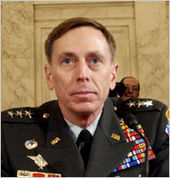 General David Petraeus in testimony before Congress on April 8, 2008
General David Petraeus in testimony before Congress on April 8, 2008
Speaking before the U.S. Congress on April 8, 2008, General David Petraeus urged delaying troop withdrawals, saying, "I've repeatedly noted that we haven't turned any corners, we haven't seen any lights at the end of the tunnel," referencing the comments of then President Bush and former Vietnam-era General William Westmoreland.[239] When asked by the Senate if reasonable people could disagree on the way forward, Petraeus said, "We fight for the right of people to have other opinions."[240]
Upon questioning by then Senate committee chair Joe Biden, Ambassador Crocker admitted that Al-Qaeda in Iraq was less important than the Al-Qaeda organization led by Osama bin Laden along the Afghan-Pakistani border.[241] Lawmakers from both parties complained that U.S. taxpayers are carrying Iraq's burden as it earns billions of dollars in oil revenues.
Iraqi security forces rearm
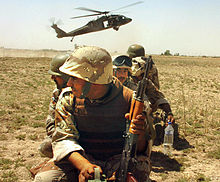 An Iraqi Army unit prepares to board a Task Force Baghdad UH-60 Blackhawk helicopter for a counterinsurgency mission in Baghdad in 2007.
An Iraqi Army unit prepares to board a Task Force Baghdad UH-60 Blackhawk helicopter for a counterinsurgency mission in Baghdad in 2007.
Iraq became one of the top current purchasers of U.S. military equipment with their army trading its AK-47 assault rifles for the U.S. M-16 and M-4 rifles, among other equipment.[242] In 2008 alone, Iraq accounted for more than $12.5 billion of the $34 billion U.S. weapon sales to foreign countries (not including the potential F-16 fighter planes.).[243]
Iraq sought 36 F-16s, the most sophisticated weapons system Iraq has attempted to purchase. The Pentagon notified Congress that it had approved the sale of 24 American attack helicopters to Iraq, valued at as much as $2.4 billion. Including the helicopters, Iraq announced plans to purchase at least $10 billion in U.S. tanks and armored vehicles, transport planes and other battlefield equipment and services. Over the summer, the Defense Department announced that the Iraqi government wanted to order more than 400 armored vehicles and other equipment worth up to $3 billion, and six C-130J transport planes, worth up to $1.5 billion.[244][245] From 2005 to 2008, the United States had completed approximately $20 billion in arms sales agreements with Iraq.[246]
Status of forces agreement
Main article: U.S.-Iraq Status of Forces AgreementThe U.S.-Iraq Status of Forces Agreement was approved by the Iraqi government on December 4, 2008.[247] It establishes that U.S. combat forces will withdraw from Iraqi cities by June 30, 2009, and that all U.S. forces will be completely out of Iraq by December 31, 2011. The pact is subject to possible negotiations which could delay withdrawal and a referendum scheduled for mid-2009 in Iraq which may require all U.S. forces to completely leave by the middle of 2010.[248][249] The pact requires criminal charges for holding prisoners over 24 hours, and requires a warrant for searches of homes and buildings that are not related to combat.[250]
U.S. contractors working for U.S. forces will be subject to Iraqi criminal law, while contractors working for the State Department and other U.S. agencies may retain their immunity. If U.S. forces commit still undecided "major premeditated felonies" while off-duty and off-base, they will be subject to the still undecided procedures laid out by a joint U.S.-Iraq committee if the U.S. certifies the forces were off-duty.[251][252][253][254]
Some Americans have discussed "loopholes"[255] and some Iraqis have said they believe parts of the pact remain a "mystery".[256] U.S. Secretary of Defense Robert Gates has predicted that after 2011 he would expect to see "perhaps several tens of thousands of American troops" as part of a residual force in Iraq.[257]
Several groups of Iraqis protested the passing of the SOFA accord[258][259][260] as prolonging and legitimizing the occupation. Tens of thousands of Iraqis burned an effigy of George W. Bush in a central Baghdad square where U.S. troops five years previously organized a tearing down of a statue of Saddam Hussein.[142][256][261] Some Iraqis expressed skeptical optimism that the U.S. would completely end its presence by 2011.[262] On December 4, 2008, Iraq's presidential council approved the security pact.[247]
A representative of Grand Ayatollah Ali Husseini al-Sistani's expressed concern with the ratified version of the pact and noted that the government of Iraq has no authority to control the transfer of occupier forces into and out of Iraq, no control of shipments, and that the pact grants the occupiers immunity from prosecution in Iraqi courts. He said that Iraqi rule in the country is not complete while the occupiers are present, but that ultimately the Iraqi people would judge the pact in a referendum.[261] Thousands of Iraqi have gathered weekly after Friday prayers and shouted anti-U.S. and anti-Israeli slogans protesting the security pact between Baghdad and Washington. A protester said that despite the approval of the Interim Security pact, the Iraqi people would break it in a referendum next year.[263]
2009: Coalition redeployment
Further information: 2009 in IraqTransfer of Green Zone
 Aerial view of the Green Zone, Baghdad International Airport and the contiguous Victory Base Complex in Baghdad.
Aerial view of the Green Zone, Baghdad International Airport and the contiguous Victory Base Complex in Baghdad.
On January 1, 2009, the United States handed control of the Green Zone and Saddam Hussein's presidential palace to the Iraqi government in a ceremonial move described by the country's prime minister as a restoration of Iraq's sovereignty. Iraqi Prime Minister Nouri al-Maliki said he would propose January 1 be declared national "Sovereignty Day". "This palace is the symbol of Iraqi sovereignty and by restoring it, a real message is directed to all Iraqi people that Iraqi sovereignty has returned to its natural status," al-Maliki said.
The U.S. military attributed a decline in reported civilians deaths to several factors including the U.S.-led "troop surge", the growth of U.S.-funded Awakening Councils, and Shiite cleric Muqtada al-Sadr's call for his militia to abide by a cease fire.[264]
Provincial elections
Main article: Iraqi governorate elections, 2009 Election map. Shows what was the largest list in every governorate.
Election map. Shows what was the largest list in every governorate.
On January 31, 2009, Iraq held provincial elections.[265] Provincial candidates and those close to them faced some political assassinations and attempted assassinations, and there was also some other violence related to the election.[266][267][268][269]
Iraqi voter turnout failed to meet the original expectations which were set and was the lowest on record in Iraq,[270] but U.S. Ambassador Ryan Crocker characterized the turnout as "large".[271] Of those who turned out to vote, some groups complained of disenfranchisement and fraud.[270][272][273] After the post-election curfew was lifted, some groups made threats about what would happen if they were unhappy with the results.[274]
Exit strategy announcement
On February 27, 2009, United States President Barack Obama gave a speech at Marine Corps Base Camp Lejeune in the U.S. state of North Carolina announcing that the U.S. combat mission in Iraq would end by August 31, 2010. A "transitional force" of up to 50,000 troops tasked with training the Iraqi Security Forces, conducting counterterrorism operations, and providing general support may remain until the end of 2011, the president added.[275]
The day before Obama's speech, Prime Minister of Iraq Nuri al-Maliki said at a press conference that the government of Iraq had "no worries" over the impending departure of U.S. forces and expressed confidence in the ability of the Iraqi Security Forces and police to maintain order without American military support.[276]
Sixth anniversary protests
On April 9, 2009, the sixth anniversary of Baghdad's fall to coalition forces, tens of thousands of Iraqis thronged Baghdad to mark the sixth anniversary of the city's fall and to demand the immediate departure of coalition forces. The crowds of Iraqis stretched from the giant Sadr City slum in northeast Baghdad to the square around 5 km (3.1 mi) away, where protesters burned an effigy featuring the face of former U.S. President George W. Bush, who ordered the U.S.-led invasion of Iraq, and also the face of Saddam[citation needed] Shi'ites were brutally persecuted under Saddam's rule.[277] There were also Sunni Muslims in the crowd. Police said many Sunnis, including prominent leaders such as a founding sheikh from the Sons of Iraq, took part.[278]
Coalition forces withdraw
On April 30, 2009, the United Kingdom formally ended combat operations. Prime Minister Gordon Brown characterized the operation in Iraq as a "success story" because of UK troops' efforts. Britain handed control of Basra to the United States Armed Forces.[279]
On July 28, 2009, Australia withdrew its combat forces as The Australian military presence in Iraq ended, per an agreement with the Iraqi government.
The withdrawal of U.S. forces began at the end of June, with 38 bases to be handed over to Iraqi forces. On June 29, 2009, U.S. forces withdrew from Baghdad. On November 30, 2009, Iraqi Interior Ministry officials reported that the civilian death toll in Iraq fell to its lowest level in November since the 2003 invasion.[280]
Iraq awards oil contracts
On June 30 and December 11, 2009, the Iraqi ministry of oil awarded contracts to international oil companies for some of Iraq's many oil fields. The winning oil companies enter joint ventures with the Iraqi ministry of oil, and the terms of the awarded contracts include extraction of oil for a fixed fee of approximately $1.40 per barrel.[281][282] The fees will only be paid once a production threshold set by the Iraqi ministry of oil is reached.
2010: U.S. drawdown and Operation New Dawn
Further information: 2010 in Iraq and Withdrawal of U.S. troops from IraqU.S. withdrawal
On February 17, 2010, U.S. Secretary of Defense Robert Gates announced that as of September 1, 2010, the name "Operation Iraqi Freedom" would be replaced by "Operation New Dawn".[283]
On April 18, 2010, US and Iraqi forces killed Abu Ayyub al-Masri the leader of al-Qaeda in Iraq in a joint American and Iraqi operation near Tikrit, Iraq.[284] The coalition forces believed al-Masri to be wearing a suicide vest and proceeded cautiously. After the lengthy exchange of fire and bombing of the house, the Iraqi troops stormed inside and found two women still alive, one of whom was al-Masri's wife, and four dead men, identified as al-Masri, Abu Abdullah al-Rashid al-Baghdadi, an assistant to al-Masri, and al-Baghdadi's son. A suicide vest was indeed found found on al-Masri's corpse, as the Iraqi Army subsequently stated.[285] Iraqi Prime Minister Nouri al-Maliki announced the killings of Abu Omar al-Baghdadi and Abu Ayyub al-Masri at a news conference in Baghdad and showed reporters photographs of their bloody corpses. "The attack was carried out by ground forces which surrounded the house, and also through the use of missiles," Mr Maliki said. "During the operation computers were seized with e-mails and messages to the two biggest terrorists, Osama bin Laden and [his deputy] Ayman al-Zawahiri," Mr Maliki added. U.S. forces commander Gen. Raymond Odierno praised the operation. "The death of these terrorists is potentially the most significant blow to al-Qaeda in Iraq since the beginning of the insurgency," he said. "There is still work to do but this is a significant step forward in ridding Iraq of terrorists."
US Vice-President Joe Biden stated that the deaths of the top two al-Qaeda figures in Iraq are "potentially devastating" blows to the terror network there and proof that Iraqi security forces are gaining ground.[286]
On 20 June, Iraq's Central Bank was bombed in an attack that left 15 people dead and brought much of downtown Baghdad to a standstill. The attack was claimed to have been carried out by the Islamic State of Iraq. This attack was followed by another attack on Iraq's Bank of Trade building that killed 26 and wounded 52 people.[287]
In late August 2010, insurgents conducted a major attack with at least 12 car bombs simultaneously detonating from Mosul to Basra and killing at least 51. These attacks coincided with the U.S. plans for a withdrawal of combat troops.[288]
The last U.S. combat brigades departed Iraq in the early morning of August 19, 2010. Convoys of U.S. troops had been moving out of Iraq to Kuwait for several days, and NBC News broadcast live from Iraq as the last convoy crossed the border. While all combat brigades left the country, an additional 50,000 personnel remained in the country to provide support for the Iraqi military.[289][290] These troops are required to leave Iraq by 31 December 2011 under an agreement between the U.S. and Iraqi governments.[291] State Dept. spokesman P.J. Crowley stated "We are ending the war.... but we are not ending our work in Iraq, We have a long-term commitment to Iraq."[1]
On August 31, 2010, Obama announced the end of Operation Iraqi Freedom from the Oval Office. In his address, he covered his next year's plan for closing operations in Afghanistan, the role of the United States' soft power, the effect the war has had on the United States economy, and the legacy of American wars.
The United States has paid a huge price to put the future of Iraq in the hands of its people. We have sent our young men and women to make enormous sacrifices in Iraq, and spent vast resources abroad at a time of tight budgets at home. We have persevered because of a belief we share with the Iraqi people—a belief that out of the ashes of war, a new beginning could be born in this cradle of civilization. Through this remarkable chapter in the history of the United States and Iraq, we have met our responsibility. Now, it is time to turn the page.—President Obama's Address on Iraq, August 31, 2010[292]On the same day in Iraq, at a ceremony at one of Saddam Hussein's former residences at Al Faw Palace in Baghdad, a number of U.S. dignitaries spoke in a ceremony for television cameras, avoiding overtones of the triumphalism present in US announcements made earlier in the war. Vice President Joe Biden expressed concerns regarding the ongoing lack of progress in forming a new Iraqi government, saying of the Iraqi people that "they expect a government that reflects the results of the votes they cast." Gen. Ray Odierno stated that the new era "in no way signals the end of our commitment to the people of Iraq." Speaking in Ramadi earlier in the day, Gates said that U.S. forces "have accomplished something really quite extraordinary here, [but] how it all weighs in the balance over time I think remains to be seen." When asked by reporters if the seven year war was worth doing, Gates commented that "It really requires a historian's perspective in terms of what happens here in the long run." He noted the Iraq War "will always be clouded by how it began" in regards Saddam Hussein's supposed weapons of mass destruction, which were never confirmed to have existed. Gates continued, "This is one of the reasons that this war remains so controversial at home." [293] On the same day Gen. Ray Odierno was replaced by Lloyd Austin as Commander of US forces in Iraq
However, there has been some controversy over whether the official declaration is accurate, with the issuance of a standards memo from the Associated Press stating "combat in Iraq is not over, and we should not uncritically repeat suggestions that it is, even if they come from senior officials." [294]
Ongoing tensions
On September 7, 2010, two U.S. troops were killed and nine wounded in an incident at an Iraqi military base. The incident is under investigation by Iraqi and U.S. forces, but it is believed that an Iraqi soldier opened fire on U.S. forces.[295]
According to reports from Iraq, hundreds of members of the Sunni Awakening Councils may have switched allegiance back to the Iraqi insurgency or al Qaeda.[296]
Wikileaks disclosed 391,832 classified U.S. military documents on the Iraq War.[297][298][299] Approximately, 58 people were killed with another 40 wounded in an attack on the Sayidat al-Nejat church, a Chaldean Catholic church in Baghdad. Responsibility for the attack was claimed by the Islamic State in Iraq organization.[300]
Coordinated attacks in primarily Shia areas struck throughout Baghdad on November 2, 2010, killing approximately 113 and wounding 250 with around 17 bombs.[301]
Iraqi security forces transition towards self reliance
Preparing to buy 13 billion dollars worth of American arms, the Iraq Defense Ministry intends to transform the country's degraded conventional forces into a state-of-the-art military and become among the world’s biggest customers for American military arms and equipment. Part of the planned purchase includes 140 M1 Abrams main battle tanks. Iraqi crews have already begun training on them. In addition to the $13 billion purchase, the Iraqis have requested 18 F-16 Fighting Falcons as part of a $4.2 billion program that also includes aircraft training and maintenance, AIM-9 Sidewinder air-to-air missiles, laser-guided bombs and reconnaissance equipment.[302] If approved by Congress, the first aircraft could arrive in spring 2013. Under the plan, the first 10 pilots would be trained in the U.S.[303]
The Iraqi navy also inaugurated U.S.-built Swift Class patrol boat at Umm Qasr, Iraq's main port at the northern end of the gulf. Iraq is to take delivery of 14 more of these $20 million, 50-foot craft before U.S. forces depart. The high-speed vessels' main mission will be to protect the oil terminals at al-Basra and Khor al-Amiya through which some 1.7 million barrels a day are loaded into tankers for export. Two U.S.-built offshore support vessels, each costing $70 million, are expected to be delivered in 2011.[302]
The United States Department of Defense had issued notification of an additional $100 million proposed sales of arms from the US to Iraq. General Dynamics is to be the prime contractor on a $36 million deal for the supply of ammunition for Iraq’s Abrams M1A1 tanks. The sale consists of: 14,010 TP-T M831A1 120mm Cartridges; 16,110 TPCSDS-T M865 120mm Cartridges; and 3,510 HEAT-MP-T M830A1 120mm Cartridges. Raytheon is proposed as the prime contractor for a $68 million package of “Command, Control, Communications, Computers, Intelligence, Surveillance and Reconnaissance (C4ISR) Systems”. .[304]
UN lifts restrictions on Iraq
In a move to legitimize the existing Iraqi government, the United Nations lifted the Saddam Hussein-era UN restrictions on Iraq. These included allowing Iraq to have a civilian nuclear program, permitting the participation of Iraq in international nuclear and chemical weapons treaties, as well as returning control of Iraq's oil and gas revenue to the government and ending the Oil-for-Food Programme.[305]
2011: End Game
Further information: 2011 in IraqMoktada al-Sadr returned to Iraq in the holy city of Najaf to lead the Sadrist movement after being in exile since 2007.[306]
During the year the proclaimed terrorist group al-Qaeda in Iraq was eventually defeated in May after Huthaifa al-Batawi was killed and who was the only man left in the group as the head leader.[citation needed]
On January 15, 2011, three U.S. troops were killed in Iraq. One of the troops was killed on a military operation in central Iraq, while the other two troops were deliberately shot by one or two Iraqi soldiers during a training exercise.[307]
On June 6, 2011, five U.S. troops were killed in an apparent rocket attack on Camp Victory, located near Baghdad International Airport.[308] A sixth soldier, who was wounded in the attack, died 10 days later of his wounds.[309]
On June 29, 2011, three U.S. troops were killed in a rocket attack on a U.S. base located near the border with Iran. It was speculated that the militant group responsible for the attack was the same one which attacked Camp Victory just over three weeks before.[310] With the three deaths, June 2011, became the bloodiest month in Iraq for the U.S. military since June 2009, with 15 U.S. soldiers killed, only one of them outside combat.[311]
In September 2011, Iraq signed a contract to buy 18 Lockheed Martin F-16 warplanes, becoming the 26th nation to operate the F-16. Because of windfall profits from oil, the Iraqi government is planning to double this originally planned 18, to 36 F-16s. Iraq is relying on the U.S. military for air support as it rebuilds its forces and battles a stubborn Islamist insurgency.[312]
On October 21, 2011 President Obama announced that all remaining U.S. troops and trainers would leave Iraq by the end of the year.[94]
Casualty estimates
Main article: Casualties of the Iraq WarSee also: Suicide bombings in Iraq since 2003 and Foreign hostages in IraqFor coalition death totals see the infobox at the top right. See also Casualties of the Iraq War, which has casualty numbers for coalition nations, contractors, non-Iraqi civilians, journalists, media helpers, aid workers, wounded, etc. The main article also gives explanations for the wide variation in estimates and counts, and shows many ways in which undercounting occurs. Casualty figures, especially Iraqi ones, are highly disputed. This section gives a brief overview.
There have been several attempts by the media, coalition governments and others to estimate the Iraqi casualties. The table below summarizes some of these estimates and methods.
Source Iraqi casualties March 2003 to ... Iraq Family Health Survey 151,000 violent deaths. June 2006 Lancet survey 601,027 violent deaths out of 654,965 excess deaths. June 2006 Opinion Research Business survey 1,033,000 violent deaths from the conflict. August 2007 Iraqi Health Ministry 87,215 violent deaths per death certificates issued.
Deaths prior to January 2005 unrecorded.
Ministry estimates up to 20% more deaths are undocumented.January 2005 to
February 2009Associated Press 133,280 violent deaths.
Health Ministry death certificates plus AP estimate of casualties for 2003–2005.April 2009 Iraq Body Count 113,494 – 122,483 violent civilian deaths.
Reported in English-language media only.
(including new deaths added from the Iraq War Logs)October 2010 Criticism and cost
Further information: Criticism of the Iraq War, Opposition to the Iraq War, Legitimacy of the 2003 invasion of Iraq, Legality of the Iraq War, Views on the 2003 invasion of Iraq, Protests against the Iraq War, American popular opinion on invasion of Iraq, Governmental positions on the Iraq War prior to the 2003 invasion of Iraq, and Media coverage of the Iraq War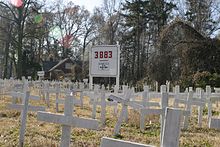 A local memorial in North Carolina in December 2007; U.S. casualty count can be seen in the background.[313]
A local memorial in North Carolina in December 2007; U.S. casualty count can be seen in the background.[313]
The Bush Administration's rationale for the Iraq War has faced heavy criticism from an array of popular and official sources both inside and outside the United States, with many U.S. citizens finding many parallels with the Vietnam War.[314] For example, the Center for Public Integrity alleges that the Bush administration made a total of 935 false statements between 2001 and 2003 about Iraq's alleged threat to the United States.[315]
Both proponents and opponents of the invasion have also criticized the prosecution of the war effort along a number of other lines. Most significantly, critics have assailed the U.S. and its allies for not devoting enough troops to the mission, not adequately planning for post-invasion Iraq, and for permitting and perpetrating widespread human rights abuses. As the war has progressed, critics have also railed against the high human and financial costs.
The court-martial of Ehren Watada, the first U.S. officer to refuse to serve in Iraq, ended in a mistrial because the Judge Advocate General's Corps would not consider the question of whether orders could be illegal. A federal district court judge ruled that Watada cannot face double jeopardy on three of his five charges, but abstained from ruling on whether the two remaining charges of conduct unbecoming an officer may still go forward.[316]
Another criticism of the initial intelligence leading up to the Iraq war comes from a former CIA officer who described the Office of Special Plans as a group of ideologues who were dangerous to U.S. national security and a threat to world peace, and that the group lied and manipulated intelligence to further its agenda of removing Saddam.[317] Subsequently, in 2008, the nonpartisan Center for Public Integrity, a group partially funded by George Soros has enumerated a total of 935 allegedly false statements made by George W. Bush and six other top members of his administration in what it termed a "carefully launched campaign of misinformation" during the two year period following 9/11 attacks, in order to rally support for the invasion of Iraq.[318][319]
Criticisms include:
- Legality of the invasion[320][321]
- Human casualties
- Insufficient post-invasion plans, in particular inadequate troop levels (a RAND study stated that 500,000 troops would be required for success)[322]
- Financial costs with approximately $612 billion spent as of 4/09 the CBO has estimated the total cost of the war in Iraq to U.S. taxpayers will be around $1.9 trillion.[323]
- Adverse effect on U.S.-led global "war on terror"[324][325]
- Damage to U.S.' traditional alliances and influence in the region, especially Israel[326] and Saudi Arabia.[327]
- Endangerment and ethnic cleansing of religious and ethnic minorities[205][328][329][330][331]
- Disruption of Iraqi oil production and related energy security concerns (the price of oil has quadrupled since 2002)[332][333]
After President Barack Obama was inaugurated in 2009, some anti-war groups decided to stop protesting even though the war was still going on. Some of them decided to stop because they felt they should give the new President time to establish his administration, and others stopped because they believed that Obama would end the war.[334]
Financial cost
The financial cost of the war has been more than £4.55 billion ($9 billion) to the UK,[335] and over $845 billion to the U.S., with the total cost to the U.S. economy estimated at $3 trillion.[336]
A CNN report noted that the U.S. led interim government, the Coalition Provisional Authority lasting until 2004 in Iraq had lost $8.8 billion in the Development Fund for Iraq. In June 2011, it was reported by CBS News that six billion in neatly packaged blocks of US $100 bills was literally air-lifted into Iraq by the George W. Bush administration, which flew it into Baghdad aboard C-130 military cargo planes. In total, the Times says $12 billion in cash was flown into Iraq in 21 separate flights by May 2004. All of which has disappeared. An inspector general's report mentioned that "'Severe inefficiencies and poor management' by the Coalition Provisional Authority would leave no guarantee that the money was properly used," said Stuart W. Bowen Jr., director of the Office of the Special Inspector General for Iraq Reconstruction. "The CPA did not establish or implement sufficient managerial, financial and contractual controls to ensure that funds were used in a transparent manner."[337] Bowen told the Times the missing money may represent "the largest theft of funds in national history."[338]
Humanitarian crises
Main articles: Humanitarian crises of the Iraq War and Refugees of IraqMalnutrition rates have risen from 19% before the U.S.-led invasion to a national average of 28% four years later.[341] Some 60–70% of Iraqi children are suffering from psychological problems.[342] 68% of Iraqis have no access to safe drinking water. A cholera outbreak in northern Iraq is thought to be the result of poor water quality.[343] As many as half of Iraqi doctors have left the country since 2003.[344]
The Foreign Policy Association reported that "Perhaps the most perplexing component of the Iraq refugee crisis... has been the inability for the U.S. to absorb more Iraqis following the 2003 invasion of the country. To date, the U.S. has granted less than 800 Iraqis refugee status, just 133 in 2007. By contrast, the U.S. granted asylum to more than 100,000 Vietnamese refugees during the Vietnam War." [345]
Human rights abuses
Main articles: Human rights in post-invasion Iraq and Suicide bombings in Iraq since 2003Throughout the entire Iraq war there have been human rights abuses on all sides of the conflict.
Iraqi government
- The use of torture by Iraqi security forces.[346]
- Iraqi police from the Interior Ministry accused of forming Death Squads and committing numerous massacres and tortures of Sunni Arabs[347] and the police collusion with militias in Iraq have compounded the problems.
Coalition forces and private contractors
- Haditha killings of 24 civilians (ongoing with some charges dropped)
- The torture and killing of prisoner of war, Iraqi Air Force commander, Abed Hamed Mowhoush
- Controversy over whether disproportionate force was used, during the assaults by Coalition and (mostly Shia and Kurdish) Iraqi government forces on the Sunni insurgent stronghold of Fallujah in 2004.
- Planting weapons on noncombatant, unarmed Iraqis by three U.S. Marines after killing them.[350][351] According to a report by The Nation, other similar acts have been witnessed by U.S. soldiers.[352] Members of Iraq Veterans Against the War tell similar stories.[353]
Insurgent groups
Main article: Iraq War insurgent attacksFurther information: Tactics of the Iraqi insurgency- Killing over 12,000 Iraqis from January 2005 to June 2006, according to Iraqi Interior Minister Bayan Jabr, giving the first official count for the victims of bombings, ambushes and other deadly attacks.[354] The insurgents have also conducted numerous suicide attacks on the Iraqi civilian population, mostly targeting the majority Shia community.[355][356] An October 2005 report from Human Rights Watch examines the range of civilian attacks and their purported justification.[357]
- Attacks against civilians including children through bombing of market places and other locations reachable by car bombs.
- Attacks on diplomats and diplomatic facilities including; the bombing of the UN headquarters in Baghdad in August 2003 killing the top UN representative in Iraq and 21 other UN staff members;[358] beheading several diplomats: two Algerian diplomatic envoys Ali Belaroussi and Azzedine Belkadi,[359] Egyptian diplomatic envoy al-Sherif,[360] and four Russian diplomats.[361]
- The February 2006 bombing of the al-Askari Mosque, destroying one of the holiest Shiite shrines, killing over 165 worshipers and igniting sectarian strife and reprisal killings.[362]
- The publicised killing of several contractors; Eugene Armstrong, Jack Hensley, Kenneth Bigley, Ivaylo Kepov and Georgi Lazov (Bulgarian truck drivers.)[363] Other non-military personnel murdered include: translator Kim Sun-il, Shosei Koda, Fabrizio Quattrocchi (Italian), charity worker Margaret Hassan, reconstruction engineer Nick Berg, photographer Salvatore Santoro (Italian)[364] and supply worker Seif Adnan Kanaan (Iraqi.) Four private armed contractors, Scott Helvenston, Jerko Zovko, Wesley Batalona and Michael Teague, were killed with grenades and small arms fire, their bodies dragged from their vehicles, beaten and set ablaze. Their burned corpses were then dragged through the streets before being hung over a bridge crossing the Euphrates.[365]
- Torture or killing of members of the New Iraqi Army,[366] and assassination of civilians associated with the Coalition Provisional Authority, such as Fern Holland, or the Iraqi Governing Council, such as Aqila al-Hashimi and Ezzedine Salim, or other foreign civilians, such as those from Kenya.[367]
Public opinion on the war
Main article: Public opinion on the Iraq WarInternational opinion
According to a January 2007 BBC World Service poll of more than 26,000 people in 25 countries, 73% of the global population disapproved of U.S. handling of the Iraq War.[368] A September 2007 poll conducted by the BBC found that two-thirds of the world's population believed the U.S. should withdraw its forces from Iraq.[369] According to an April 2004 USA Today/CNN/Gallup Poll, only a third of the Iraqi people believed that "the American-led occupation of their country is doing more good than harm, and a solid majority support an immediate military pullout even though they fear that could put them in greater danger."[370] In 2006 it was found that majorities in the UK and Canada believed that the war in Iraq was "unjustified" and – in the UK – were critical of their government's support of U.S. policies in Iraq.[371]
According to polls conducted by the Arab American Institute, four years after the invasion of Iraq, 83% of Egyptians had a negative view of the U.S. role in Iraq; 68% of Saudi Arabians had a negative view; 96% of the Jordanian population had a negative view; 70% of the population of the United Arab Emirates and 76% of the Lebanese population also described their view as negative.[372] The Pew Global Attitudes Project reports that in 2006 majorities in the Netherlands, Germany, Jordan, France, Lebanon, China, Spain, Indonesia, Turkey, Pakistan, and Morocco believed the world was safer before the Iraq War and the toppling of Hussein. Pluralities in the U.S. and India believe the world is safer without Hussein.[373]
Iraqi opinion
 A woman pleads with an Iraqi army soldier from 2nd Company, 5th Brigade, 2nd Iraqi Army Division to let a suspected insurgent free during a raid near Tafaria, Iraq
A woman pleads with an Iraqi army soldier from 2nd Company, 5th Brigade, 2nd Iraqi Army Division to let a suspected insurgent free during a raid near Tafaria, Iraq
From 2005 to 2007, polls consistently showed that a majority of Iraqis opposed the U.S. invasion.[374][375][376]
Relation to the U.S. Global War on Terrorism
Main article: Iraq War and U.S. Global War on TerrorFurther information: Saddam Hussein and al-Qaeda, Saddam Hussein and al-Qaeda timeline, and Criticism of the War on TerrorismFormer President George W. Bush consistently referred to the Iraq war as "the central front in the War on Terror", and argued that if the U.S. pulled out of Iraq, "terrorists will follow us here."[377][378][379] While other proponents of the war have regularly echoed this assertion, as the conflict has dragged on, members of the U.S. Congress, the U.S. public, and even U.S. troops have begun to question the connection between Iraq and the fight against anti-U.S. terrorism. In particular, a consensus has developed among intelligence experts that the Iraq war has increased terrorism. Counterterrorism expert Rohan Gunaratna frequently refers to the invasion of Iraq as a "fatal mistake."[380]
London's conservative International Institute for Strategic Studies concluded in 2004 that the occupation of Iraq had become "a potent global recruitment pretext" for mujahideen and that the invasion "galvanised" al-Qaeda and "perversely inspired insurgent violence" there.[381] The U.S. National Intelligence Council concluded in a January 2005 report that the war in Iraq had become a breeding ground for a new generation of terrorists; David Low, the national intelligence officer for transnational threats, indicated that the report concluded that the war in Iraq provided terrorists with "a training ground, a recruitment ground, the opportunity for enhancing technical skills ... There is even, under the best scenario, over time, the likelihood that some of the jihadists who are not killed there will, in a sense, go home, wherever home is, and will therefore disperse to various other countries." The Council's chairman Robert Hutchings said, "At the moment, Iraq is a magnet for international terrorist activity."[382] And the 2006 National Intelligence Estimate, which outlined the considered judgment of all 16 U.S. intelligence agencies, held that "The Iraq conflict has become the 'cause celebre' for jihadists, breeding a deep resentment of U.S. involvement in the Muslim world and cultivating supporters for the global jihadist movement."[383]
Iranian involvement
Although some military intelligence analysts have concluded there is no concrete evidence, it has been claimed that Iran has provided training, weapons, money, and intelligence to Shiite insurgents in Iraq and that up to 150 Iranian intelligence agents, plus members of the Iranian Revolutionary Guard are believed to be active in Iraq at any given time.[384][385] Members of the Iranian Quds Force and the Iranian Revolutionary Guard are thought to have trained members of the Qazali terror network in explosives technology and also provided the network with arms, munitions, and military advisors. Many explosive devices, including improvised explosives (IEDs) and armor-piercing penetrators (EFPs), used by insurgents are claimed to be Iranian-made or designed.
In January 2008, Multi-National Force – Iraq (MNFI) initiated Task Force Troy to identify Iranian-made weapons. Their report was delivered in July 2008. Of 4,600 weapons caches discovered, only 98 contained at least one Iranian-made weapon with these representing less than one half percent of the total number of weapons recovered. No Iranian weapons were discovered in Karbala or Basra and of the 350 armor-piercing explosively formed penetrators (EFPs) found, none were of Iranian origin. Despite frequent claims that Iran is supplying weapons to insurgents, the MNFI report criticized official U.S. statements on Iranian weapons, stating; "Iranian munitions found in Iraq were likely purchased on the open market."[386]
According to two unnamed U.S. officials, the Pentagon is examining the possibility that the Karbala provincial headquarters raid, in which insurgents managed to infiltrate an American base, kill five U.S. soldiers, wound three, and destroy three humvees before fleeing, was supported by Iranians. In a speech on 31 January 2007, Iraqi Prime Minister Nouri al-Maliki stated that Iran was supporting attacks against Coalition forces in Iraq[387] and some Iraqis suspect that the raid may have been perpetrated by the Islamic Revolutionary Guards Corps's Qods Force in retaliation for the detention of five Iranian officials by U.S. forces in the northern Iraqi city of Irbil on 11 January.[388][389]
See also
- Carter Doctrine
- Covert United States foreign regime change actions
- Overseas interventions of the United States
- Canada and the Iraq War
- Canada and Iraq War resisters
- Iraq prison abuse scandals
- July 12, 2007, Baghdad airstrike (associated with WikiLeaks in 2010)
- The International Criminal Court and the 2003 invasion of Iraq
- United Nations Security Council and the Iraq War
- List of Iraq War resisters
- List of modern conflicts in the Middle East
- List of United Nations Security Council resolutions concerning Iraq
- List of wars 2003–current
References
- ^ a b The Mouth of the Potomac (2010-08-19). "War is over: Last U.S. combat troops leave Iraq; 50,000 remain as advisers". New York: Nydailynews.com. http://www.nydailynews.com/news/national/2010/08/18/2010-08-18_troops_out_of_iraq_cross_border_drawing_war_to_close_50k_remain_to_advise_train.html. Retrieved 2011-01-15.
- ^ Post Store (2010-09-01). "Obama's speech on August 31 declares combat in Iraq over". Washingtonpost.com. http://www.washingtonpost.com/wp-dyn/content/article/2010/09/01/AR2010090101607.html. Retrieved 2011-01-15.
- ^ Post Store (2010-08-31). "As Obama declares Iraq war over, Iraqis brace for uncertainty". Washingtonpost.com. http://www.washingtonpost.com/wp-dyn/content/article/2010/08/31/AR2010083105193.html. Retrieved 2011-01-15.
- ^ "Obama delivers Oval Office address on Iraq | In Obama's Words | The Washington Post". Projects.washingtonpost.com. 2010-08-31. http://projects.washingtonpost.com/obama-speeches/speech/380/. Retrieved 2011-01-15.
- ^ Dershowitz, Alan. "Obama marks formal end of Iraq combat". Jpost.com. http://www.jpost.com/MiddleEast/Article.aspx?id=186266. Retrieved 2011-01-15.
- ^ Brush, Silla (2010-08-28). "Obama: 'The war is ending,' fulfilling campaign pledge". TheHill.com. http://thehill.com/homenews/administration/116179-obama-the-war-is-ending-fulfilling-campaign-pledge. Retrieved 2011-01-15.
- ^ New York Times, January 24, 2010
- ^ "Microsoft Word - FINAL 23 1000 Jul SecDef singed.doc" (PDF). http://www.defense.gov/pubs/pdfs/9010_Report_to_CongressJul09.pdf. Retrieved 2011-01-15.
- ^ "Sectarian divisions change Baghdad’s image". MSNBC. 2006-07-03. http://www.msnbc.msn.com/id/13684759/. Retrieved 2007-02-18.
- ^ "U.S. says Iraq pullout won't cause dramatic violence". MSNBC. 2010-11-18. http://www.msnbc.msn.com/id/40257752. Retrieved 26 November 2010.
- ^ "UK 'to continue deporting failed Iraqi asylum seekers'". BBC. 2010-11-22. http://www.bbc.co.uk/news/uk-politics-11816974. Retrieved 26 November 2010.
- ^ CNN Wire Staff (21 October 2011). "Obama: Iraq war will be over by year's end; troops coming home". CNN. http://articles.cnn.com/2011-10-21/middleeast/world_meast_iraq-us-troops_1_iraq-war-operation-new-dawn-iraq-and-afghanistan-veterans?_s=PM:MIDDLEEAST. Retrieved 22 October 2011.
- ^ International Institute for Strategic Studies; Hackett, James (ed.) (2010-02-03). The Military Balance 2010. London: Routledge. ISBN 1857435575.
- ^ Rubin, Alissa J.; Nordland, Rod (March 29, 2009). "Troops Arrest an Awakening Council Leader in Iraq, Setting Off Fighting". The New York Times. http://www.nytimes.com/2009/03/29/world/middleeast/29iraq.html?hpw. Retrieved March 30, 2010.
- ^ "The Kurdish peshmerga forces will not be integrated into the Iraqi army: Mahmoud Sangawi - Interview". Ekurd.net. 2010-01-22. http://www.ekurd.net/mismas/articles/misc2010/1/independentstate3441.htm. Retrieved 2010-10-23.
- ^ "Deputy Assistant Secretary for International Programs Charlene Lamb's Remarks on Private Contractors in Iraq". State.gov. 2009-07-17. http://www.state.gov/m/ds/rls/rm/143420.htm. Retrieved 2010-10-23.
- ^ The Brookings Institution Iraq Index: Tracking Variables of Reconstruction & Security in Post-Saddam Iraq October 1, 2007
- ^ Ricks, Thomas E.; Ann Scott Tyson (2007-01-11). "Intensified Combat on Streets Likely". Washington Post. p. A01. http://www.washingtonpost.com/wp-dyn/content/article/2007/01/10/AR2007011002581_pf.html.
- ^ Pincus, Walter. "Violence in Iraq Called Increasingly Complex". Washington Post, November 17, 2006.
- ^ 260 killed in 2003,[1] 15,196 killed from 2004 through 2009 (with the exceptions of May 2004 and March 2009),[2] 67 killed in March 2009,[3] and 1,100 killed in 2010,[4] thus giving a total of 16,623 dead
- ^ http://fpc.state.gov/documents/organization/77707.pdf
- ^ "Operation Iraqi Freedom". iCasualties. http://icasualties.org/Iraq/index.aspx. Retrieved 2010-08-24.
- ^ "Home and Away: Iraq and Afghanistan War Casualties". CNN. http://www.cnn.com/SPECIALS/2003/iraq/forces/casualties/index.html. Retrieved March 30, 2010.
- ^ http://www.defenselink.mil/news/casualty.pdf
- ^ "Ministry of Defence | Fact Sheets | Operations Factsheets | Operations in Iraq: British Fatalities". Mod.uk. http://www.mod.uk/DefenceInternet/FactSheets/OperationsFactsheets/OperationsInIraqBritishFatalities.htm. Retrieved 2009-10-17.
- ^ "Forces: U.S. & Coalition/POW/MIA". CNN. http://www.cnn.com/SPECIALS/2003/iraq/forces/pow.mia/index.html. Retrieved February 22, 2011.; As of May 2011, eight Americans remain unaccouted for, including seven private contractors and one military servicemember. Their names are: Jeffrey Ake, Aban Elias, Abbas Kareem Naama, Neenus Khoshaba, Bob Hamze, Dean Sadek, Hussain al-Zurufi and Staff Sergeant Ahmed Altaie. Healy, Jack, "With Withdrawal Looming, Trails Grow Cold For Americans Missing In Iraq", New York Times, 22 May 2011, p. 6.
- ^ http://www.defense.gov/NEWS/casualty.pdf
- ^ 33 Ukranians [5], 31+ Italians [6][7], 30 Bulgarians [8][9], 20 Salvadorans [10], 19 Georgians [11], 18 Estonians [12], 16+ Poles [13][14][15][16][17], 15 Spaniards [18][19][20][21], 10 Romanians [22], 6 Australians [23], 5 Albanians, 4 Kazakhs [24], 3 Filipinos [25] and 2 Thais [26][27] for a total of 212+
- ^ a b Many official U.S. tables at "Military Casualty Information". See latest totals for injury, disease/other medical
- ^ "Casualties in Iraq".
- ^ a b iCasualties.org (was lunaville.org). Benicia, California. Patricia Kneisler, et al., "Iraq Coalition Casualties"
- ^ a b "Defence Internet Fact Sheets Operations in Iraq: British Casualties". UK Ministry of Defense. Latest combined casualty and fatality tables.
- ^ http://siadapp.dmdc.osd.mil/personnel/CASUALTY/oif-total.pdf
- ^ a b "U.S. Department of Labor - Office of Workers' Compensation Programs (ESA) - Office of Workers' Compensation Programs (OWCP) - Division of Longshore and Harbor Workers' Compensation (DLHWC)". Dol.gov. http://www.dol.gov/owcp/dlhwc/dbaallemployer.htm. Retrieved 2010-10-23.
- ^ a b T. Christian Miller (2009-09-23). "U.S. Government Private Contract Worker Deaths and Injuries". Projects.propublica.org. http://projects.propublica.org/tables/contractor_casualties. Retrieved 2010-10-23.
- ^ 185 in Diyala from June 2007 to December 2007,[28] 4 in assasination of Abu Risha, 25 on November 12, 2007,[29] 528 in 2008,[30] 27 on January 2, 2009,[31] 53 From April 6 to April 12, 2009,[32] 13 on November 16, 2009,[33] 15 in December 2009,[34] 100+ from April to June 2010,[35][36] 52 on July 18, 2010 [37][38], total of 1,002+ dead
- ^ Moore, Solomon; OPPEL Jr, RICHARD A. (2008-01-24). "Attacks Imperil U.S.-Backed Militias in Iraq". The New York Times. http://www.nytimes.com/2008/01/24/world/middleeast/24sunni.html?_r=1&pagewanted=print.
- ^ http://www.cfr.org/iraq/finding-place-sons-iraq/p16088
- ^ Press release (October 28, 2003). "New Study Finds: 11,000 to 15,000 Killed in Iraq War; 30 Percent are Non-Combatants; Death Toll Hurts Postwar Stability Efforts, Damages US Image Abroad". Project on Defense Alternatives (via Common Dreams NewsCenter). Accessed September 2, 2010.
- ^ Conetta, Carl (October 23, 2003). "The Wages of War: Iraqi Combatant and Noncombatant Fatalities in the 2003 Conflict — Project on Defense Alternative Research Monograph #8". Project on Defense Alternatives (via Commonwealth Institute). Accessed September 2, 2010.
- ^ 597 killed in 2003,[39], 23,984 killed from 2004 through 2009 (with the exceptions of May 2004 and March 2009),[40] 652 killed in May 2004,[41] 45 killed in March 2009,[42] 676 killed in 2010,[43] 451 killed in 2011 (with the exception of February),[44][45][46][47][48][49][50][51][52] thus giving a total of 26,405 dead
- ^ Van, Bill. "US Transfer of Iraqi Prisoners: An Ongoing War Crime". Globalresearch.ca. http://www.globalresearch.ca/index.php?context=va&aid=21046. Retrieved 2011-01-15.
- ^ "Amnesty: Iraq holds up to 30,000 detainees without trial". CNN. 2010-09-13. http://articles.cnn.com/2010-09-13/world/iraq.detainees_1_detainees-iraqi-authorities-moussawi?_s=PM:WORLD. Retrieved 2011-01-06.
- ^ "Iraq Body Count". Iraq Body Count. http://www.iraqbodycount.org/. Retrieved 2011-10-25.
- ^ "Iraq War Logs: What the numbers reveal". Iraq Body Count. http://www.iraqbodycount.org/analysis/numbers/warlogs/. Retrieved 2010-12-03.
- ^ "Mortality after the 2003 invasion of Iraq: a cross-sectional cluster sample survey"[dead link]PDF (242 KB). By Gilbert Burnham, Riyadh Lafta, Shannon Doocy, and Les Roberts. The Lancet, October 11, 2006
- ^ The Human Cost of the War in Iraq: A Mortality Study, 2002–2006PDF (603 KB). By Gilbert Burnham, Shannon Doocy, Elizabeth Dzeng, Riyadh Lafta, and Les Roberts. A supplement to the second Lancet study.
- ^ "Iraq Family Health Survey" New England Journal of Medicine January 31, 2008
- ^ "A chronology of the six-week invasion of Iraq". PBS. February 26, 2004. http://www.pbs.org/wgbh/pages/frontline/shows/invasion/cron/. Retrieved 2008-03-19.
- ^ Kevin Baker "The Quietest War: We've Kept Fallujah, but Have We Lost Our Souls?" American Heritage, Oct. 2006.
- ^ Schifferes, Steve (March 18, 2003). "U.S. Names Coalition of the Willing". BBC News. http://news.bbc.co.uk/2/hi/americas/2862343.stm. Retrieved 2007-11-03.
- ^ Center for American Progress (January 29, 2004) "In Their Own Words: Iraq's 'Imminent' Threat" americanprogress.org
- ^ a b Senator Bill Nelson (January 28, 2004) "New Information on Iraq's Possession of Weapons of Mass Destruction", Congressional Record
- ^ Blair, Tony. (March 5, 2002) "PM statement on Iraq following UN Security Council resolution" Number 10 Downing Street
- ^ a b c d Blix, H. (March 7, 2003) "Transcript of Blix's UN presentation" CNN.com
- ^ Hersh, Seymour M. (May 5, 2003). Selective Intelligence, New Yorker.
- ^ Pincus, Walter (2007-02-08). "Official's Key Report On Iraq Is Faulted". Washington Post. http://www.washingtonpost.com/wp-dyn/content/article/2007/02/08/AR2007020802387.html. Retrieved 2008-11-04.
- ^ U.S. Senate Intelligence Community (June 2008): "Two Bipartisan Reports Detail Administration Misstatements on Prewar Iraq Intelligence, and Inappropriate Intelligence Activities by Pentagon Policy Office". "There is a fundamental difference between relying on incorrect intelligence and deliberately painting a picture to the American people that you know is not fully accurate." – Senator John D. (Jay) Rockefeller IV
- ^ a b In his remarks to the UN Security Council on 14.2.2003 Hans Blix said on cooperation that "In my 27 January update to the Council, I said that it seemed from our experience that Iraq had decided in principle to provide cooperation on process, most importantly prompt access to all sites and assistance to UNMOVIC in the establishment of the necessary infrastructure. This impression remains and we note that access to sites has so far been without problems." On time remaining until the confirmation of disarmament he said "the period of disarmament through inspection could still be short if immediate, active and unconditional cooperation with UNMOVIC and IAEA were to be forthcoming." United Nations Security Council: 4707th meeting. Friday, 14 February 2003, 10 a.m., New York, New York, U.S.
- ^ "Iraq Survey Group Final Report: Weapons of Mass Destruction (WMD)". http://www.globalsecurity.org/wmd/library/report/2004/isg-final-report/isg-final-report_vol1_rsi-06.htm.
- ^ Shrader, K. (June 22, 2006) "New Intel Report Reignites Iraq Arms Fight" Associated Press
- ^ "Saddam's al Qaeda Connection". Weeklystandard.com. 2003-08-22. http://www.weeklystandard.com/Content/Public/Articles/000/000/003/033jgqyi.asp. Retrieved 2010-10-23.
- ^ Woods, K.M. and Lacey, J. (2008) "Saddam and Terrorism: Emerging Insights from Captured Iraqi Documents," vol. 1 Institute for Defense Analyses IDA Paper P-4287, pp. ES-1
- ^ Kerr, R.J., et al. (29 July 2004) "Intelligence and Analysis on Iraq: Issues for the Intelligence Community," MORI Doc. ID 1245667 (Langley, VA: Central Intelligence Agency)
- ^ CNN (September 12, 2002) "White House spells out case against Iraq", "the White House released a report early Thursday, listing some of the principal accusations against Iraq and its leader ... Iraq is also accused of sheltering two Palestinian terrorist organizations, and it lists Saddam's decision in 2002 to increase from $10,000 to $25,000 the bounty paid to the families of Palestinian suicide bombers."
- ^ Wolfowitz, P. (May 30, 2003)
- ^ "President Discusses the Future of Iraq" The White House, February 26, 2003
- ^ "Bush Sought 'Way' To Invade Iraq?" 60 Minutes
- ^ U.S. Defense Secretary Robert Gates, 2 Feb 2007, see "four wars" remark
- ^ "CBS on civil war". CBS News. September 26, 2006. http://www.cbsnews.com/stories/2005/09/26/eveningnews/main886305.shtml.
- ^ "CIA World Factbook: Iraq". Cia.gov. https://www.cia.gov/library/publications/the-world-factbook/geos/iz.html. Retrieved 2011-01-15.
- ^ UNHCR – Iraq: Latest return survey shows few intending to go home soon. Published April 29, 2008. Retrieved May 20, 2008.
- ^ 5 million Iraqi orphans, anti-corruption board reveals English translation of Aswat Al Iraq newspaper December 15, 2007
- ^ "Iraq: no let-up in the humanitarian crisis" (PDF). http://www.icrc.org/web/eng/siteeng0.nsf/htmlall/iraq-report-170308/$file/ICRC-Iraq-report-0308-eng.pdf. Retrieved 2010-10-23.
- ^ "U.S. Department of Defense (June 2008): Measuring Security and Stability in Iraq" (PDF). Archived from the original on 2008-07-25. http://web.archive.org/web/20080725064601/http://www.defenselink.mil/pubs/pdfs/Master_16_June_08_+FINAL_SIGNED+.pdf. Retrieved 2010-10-23.
- ^ "2010 Failed States Index - Interactive Map and Rankings". Foreign Policy. http://www.foreignpolicy.com/articles/2010/06/21/2010_failed_states_index_interactive_map_and_rankings. Retrieved 2011-01-15.
- ^ Britain's Brown visits officials, troops in Iraq. International Herald Tribune, October 2, 2007.
- ^ Italy plans Iraq troop pull-out BBC March 15, 2005
- ^ http://www.acq.osd.mil/log/PS/p_vault/SE_SOFA.pdf
- ^ Strategic Framework Agreement (pdf bitmap)
- ^ English Language Teaching and Learning Program (U.S. State Dept.)
- ^ Karadsheh, J. (November 27, 2008) "Iraq parliament OKs pact on U.S. troops' future" CNN
- ^ Thomma, Steven (February 27, 2009). "Obama to extend Iraq withdrawal timetable; 50,000 troops to remain". McClatchy Newspapers. http://www.mcclatchydc.com/227/story/62930.html.
- ^ Feller, Ben (February 27, 2009). "Obama sets firm withdrawal timetable for Iraq". Associated Press. http://news.yahoo.com/s/ap/20090227/ap_on_go_pr_wh/obama_iraq.[dead link]
- ^ Martina Stewart (2009-04-12). "General: U.S. should be out of Iraq by late 2011". Cnn.com. http://www.cnn.com/2009/WORLD/meast/04/12/iraq.us.troops/index.html. Retrieved 2010-10-23.
- ^ "UK Iraq combat operations to end". BBC News. April 30, 2009. http://news.bbc.co.uk/1/hi/uk/8026136.stm. Retrieved 2009-04-30.
- ^ "Iraq Welcomes Faster U.S. Withdrawal Reports". Foxnews.com. 2009-02-25. http://www.foxnews.com/story/0,2933,499866,00.html. Retrieved 2010-10-23.
- ^ Londoño, Ernesto (August 19, 2010). "Operation Iraqi Freedom ends as last combat soldiers leave Baghdad". The Washington Post. http://www.washingtonpost.com/wp-dyn/content/article/2010/08/18/AR2010081805644.html.
- ^ The New York Times. http://www.nytimes.com/reuters/2010/08/31/world/middleeast/international-us-iraq.html?_r=1.[dead link]
- ^ "Obama's full speech: 'Operation Iraqi Freedom is over'". MSNBC. 2010-08-31. http://www.msnbc.msn.com/id/38944049/ns/politics-white_house. Retrieved 2010-10-23.
- ^ "Combat brigades in Iraq under different name - Army News | News from Afghanistan & Iraq". Army Times. 2010-08-19. http://www.armytimes.com/news/2010/08/dn-brigades-stay-under-different-name-081910/. Retrieved 2011-01-15.
- ^ AP Issues Standards Memo: 'Combat In Iraq Is Not Over'
- ^ AP Tells Its Reporters to Avoid Saying the Iraq War Is Over
- ^ a b "Barack Obama: All US troops to leave Iraq in 2011". BBC News. http://www.bbc.co.uk/news/world-us-canada-15410154. Retrieved 21 October 2011.
- ^ "U.S. silence on new Iraq spying allegations". BBC News. 1999-01-07. http://news.bbc.co.uk/2/hi/middle_east/250808.stm. Retrieved 2010-10-23.
- ^ "Saddam's uranium headed for Ontario processing plant". The Star. Associated Press (Toronto). 2008-07-05. http://www.thestar.com/News/Ontario/article/455063. Retrieved March 30, 2010.
- ^ Duffy, Michael; James Carney (2003-07-13). "A Question of Trust". Time. http://www.time.com/time/magazine/article/0,9171,1101030721-464405,00.html.
- ^ Roberts, Pat; Rockefeller, John D., IV (2004). "Niger: Former Ambassador" (PDF). Report on the u.s. intelligence community's prewar intelligence assessments on iraq. United States Senate: Select Committee on Intelligence. pp. 39–47. http://www.globalsecurity.org/intell/library/congress/2004_rpt/iraq-wmd-intell_chapter2-b.htm
- ^ Rycroft, Matthew (2005-05-01). "The secret Downing Street memo". London: The Sunday Times. http://www.timesonline.co.uk/tol/news/politics/election2005/article387390.ece.
- ^ Silberman, Laurence H.; Robb, Charles S. (2005). "Iraq" (PDF). Report to the President of the United States. The Commission on the Intelligence Capabilities of the United States Regarding Weapons of Mass Destruction. p. 198. http://www.globalsecurity.org/intell/library/reports/2005/wmd_report_25mar2005_chap01.htm "Iraq was prohibited from possessing tubes composed of 7075 T6 aluminum alloy with outer diameters exceeding 75 mm under Annex III to United Nations Security Council Resolution 687 because of their potential use in gas centrifuges."
- ^ John Pike. "Commission on the Intelligence Capabilities of the United States Regarding Weapons of Mass Destruction". Globalsecurity.org. http://www.globalsecurity.org/intell/library/reports/2005/wmd_report_25mar2005_chap01.htm. Retrieved 2010-10-23.
- ^ a b The CIA's Aluminum Tubes' Assessment: Institute for Science and International Security March 10, 2003
- ^ Spinning The Tubes Four Corners Australian Broadcasting Corporation air date October 27, 2003
- ^ "Powell's remarks". Iraqwatch.org. 2003-02-05. http://www.iraqwatch.org/government/US/State/state-powell-un-020503.htm. Retrieved 2010-10-23.
- ^ "Evidence on Iraq Challenged," Joby Warrick, The Washington Post, Sept. 19, 2002
- ^ Colin Powell's speech to the UN, Feb 5, 2003
- ^ Meet the Press NBC, May 16, 2004
- ^ Goldenberg, Suzanne (December 2, 2008). "Iraq war my biggest regret, Bush admits". London: www.guardian.co.uk. http://www.guardian.co.uk/world/2008/dec/02/george-bush-iraq-interview. Retrieved 2 December 2008.
- ^ Pincus, Walter (2006-03-23). "Ex-Iraqi Official Unveiled as Spy". Washington Post. http://www.washingtonpost.com/wp-dyn/content/article/2006/03/22/AR2006032202103.html.
- ^ Blumenthal, S. (September 6, 2007) "Bush knew Saddam had no weapons of mass destruction" Salon.com
- ^ Martin Chulov; Helen Pidd (15 February 2011). "Curveball: How US was duped by Iraqi fantasist looking to topple Saddam". London: guardian.co.uk. http://www.guardian.co.uk/world/2011/feb/15/curveball-iraqi-fantasist-cia-saddam. Retrieved 3 March 2011.
- ^ Reynolds, Paul (12 December 2009). "Unashamed Blair confirms his critics' claims on Iraq". BBC News. http://news.bbc.co.uk/1/hi/uk_politics/8409596.stm. Retrieved 15 December 2009.
- ^ Norton-Taylor, Richard (4 December 2002). "Britain and U.S. step up bombing in Iraq". London: The Guardian. http://www.guardian.co.uk/world/2002/dec/04/iraq.richardnortontaylor. Retrieved 31 August 2010.
- ^ Smith, Michael (May 29, 2005). "RAF bombing raids tried to goad Saddam into war". London: The Sunday Times. http://www.timesonline.co.uk/tol/news/uk/article527701.ece. Retrieved 31 August 2010.
- ^ Lowe, C. (December 16, 2003) "Senator: White House Warned of UAV Attack," Defense Tech
- ^ John Pike. "Commission of the Intelligence capabilities of the United States regarding weapons of mass destruction". Globalsecurity.org. http://www.globalsecurity.org/intell/library/reports/2005/wmd_report_25mar2005_chap01.htm. Retrieved 2010-10-23.
- ^ a b Blix's remarks January 27, 2003
- ^ George W. Bush. "Third State of the Union Address". http://en.wikisource.org/wiki/George_W._Bush%27s_Third_State_of_the_Union_Address. "From three Iraqi defectors we know that Iraq, in the late 1990s, had several mobile biological weapons labs. These are designed to produce germ warfare agents, and can be moved from place to a place to evade inspectors. Saddam Hussein has not disclosed these facilities. He's given no evidence that he has destroyed them."
- ^ American Unbound: The Bush Revolution in Foreign Policy (Washington, D.C., 2003), 159–61.
- ^ www.abcnews.go.com, February 15, 2011, "Iraqi Defector "Curveball" Admits WMD Lies, Is Proud of Tricking US" by Lee Farran
- ^ Joint Declaration by Russia, Germany and France on Iraq France Diplomatie February 10, 2003
- ^ Russian/Ukrainian rebuff for Blair over Iraq The Guardian October 11, 2002
- ^ "Bush-Blair Iraq war memo revealed". BBC News Online. 2006-03-27. http://news.bbc.co.uk/2/hi/americas/4849744.stm. Retrieved January 5, 2010.
- ^ "CNN Inside Politics". Transcripts.cnn.com. http://transcripts.cnn.com/TRANSCRIPTS/0210/02/ip.00.html. Retrieved 2010-10-23.
- ^ Grice, Andrew (2002-10-03). "The Independent. "Clinton urges caution over Iraq as Bush is granted war powers"". London: Independent.co.uk. http://www.independent.co.uk/news/world/politics/clinton-urges-caution-over-iraq-as-bush-is-granted-war-powers-607775.html. Retrieved 2010-10-23.
- ^ "Press conference of Foreign affairs Minister Dominique de Villepin (excerpts)". Embassy of France in the U.S. 2003-01-20. Archived from the original on September 27, 2006. http://web.archive.org/web/20060927144309/http://www.ambafrance-us.org/news/statmnts/2003/vilepin012003.asp. Retrieved 2007-02-13.
- ^ Anti-war protests do make a difference[dead link], Alex Callinicos, Socialist Worker, March 19, 2005.
- ^ "– Army chief: Force to occupy Iraq massive". Usatoday.com. 2003-02-25. http://www.usatoday.com/news/world/iraq/2003-02-25-iraq-us_x.htm. Retrieved 2010-10-23.
- ^ "– Administration fends off demands for war estimates – Mar. 3, 2003". Cnn.com. 2003-02-26. http://www.cnn.com/2003/ALLPOLITICS/02/27/sprj.irq.war.cost/. Retrieved 2010-10-23.
- ^ Top judge: U.S. and UK acted as 'vigilantes' in Iraq invasion, The Guardian, November 18, 2008
- ^ Clegg brands Iraq War illegal in his first PMQs – with the backing of No10, dailymail.co.uk, 21 July 2010
- ^ Fukuyama, Francis (17 January 2011). "US democracy has little to teach China". The Financial Times. http://www.ft.com/cms/s/0/cb6af6e8-2272-11e0-b6a2-00144feab49a.html#axzz1BQaq1ynK. Retrieved 18 January 2011.(registration required)
- ^ a b Operation Hotel California, The Clandestine War inside Iraq, Mike Tucker and Charles Faddis, 2008.
- ^ a b c Plan of Attack, Bob Woodward, 2004.
- ^ A NATION AT WAR: SECOND FRONT; Allied Troops Are Flown In To Airfields In North Iraq, By C. J. CHIVERS, March 24, 2003
- ^ A NATION AT WAR: IN THE FIELD THE NORTHERN FRONT; Militants Gone, Caves in North Lie Abandoned By C. J. CHIVERS, March 30, 2003
- ^ "Operation Iraqi Freedom". Target Iraq. GlobalSecurity.org. 2005-04-27. http://www.globalsecurity.org/military/ops/iraqi_freedom.htm.
- ^ "Press Briefing by Ari Fleischer". Office of the Press Secretary. 2003-03-24. http://georgewbush-whitehouse.archives.gov/news/releases/2003/03/20030324-4.html. Retrieved 2008-11-27. "March 24, 2003... discussed the ongoing aspects of Operation Iraqi liberation"
- ^ Australian Department of Defence (2004). The War in Iraq. ADF Operations in the Middle East in 2003. Page 11.
- ^ "Surrogate Warfare: The Role of U.S. Army Special Forces - MAJ Isaac J. Peltier, U.S. Army – p. 29". http://cgsc.cdmhost.com/cgi-bin/showfile.exe?CISOROOT=/p4013coll3&CISOPTR=363. Retrieved 2009-09-13.
- ^ West, Bing; General Ray L. Smith (September 2003). The March Up: Taking Baghdad with the 1st Marine Division. New York: Bantam Books. ISBN 0-553-80376-X.
- ^ a b Zucchino, David (2004-07-03). "Army Stage-Managed Fall of Hussein Statue". LA Times. http://articles.latimes.com/2004/jul/03/nation/na-statue3. Retrieved 2010-10-23.
- ^ The Rachel Maddow Show. August 18, 2010, MSNBC
- ^ "Iraqi Protesters Burn Bush Effigy". Cbsnews.com. 2008-11-21. http://www.cbsnews.com/stories/2008/11/21/iraq/main4623010.shtml. Retrieved 2010-10-23.
- ^ Collier, R. (April 9, 2003) "Baghdad closer to collapse" San Francisco Chronicle
- ^ "Stuff Happens". Defenselink.mil. http://www.defenselink.mil/Transcripts/Transcript.aspx?TranscriptID=2367. Retrieved 2010-10-23.
- ^ Conetta, C. (October 20, 2003) "The Wages of War: Iraqi Combatant and Noncombatant Fatalities in the 2003 Conflict," Research Monograph no. 8 Project on Defense Alternatives
- ^ Reuters. "Getting amputees back on their feet".Washington Post. Oct. 25, 2005.
- ^ "Iraq Coalition Casualty Count"[dead link] March 19, 2003, through May 1, 2003 (end of major combat) iCasualties.org
- ^ ISG's Duelfer Report[dead link]
- ^ "Operation Iraqi Freedom Maps". GlobalSecurity.Org. Unavailable. http://www.globalsecurity.org/military/ops/iraqi_freedom-ops-maps.htm.
- ^ "iCasualties: Iraq Coalition Casualty Count - Deaths by Province Year/Month". Icasualties.org. Archived from the original on July 8, 2008. http://web.archive.org/web/20080708203616/http://icasualties.org/oif/Province.aspx. Retrieved 2008-10-27.
- ^ "Poll: Iraqis out of patience". USA Today. 2004-04-30. http://www.newsmax.com/archives/articles/2005/1/13/232154.shtml.
- ^ Reuters. "Gloom descends on Iraqi leaders as civil war looms". http://www.turkishdailynews.com.tr/article.php?enewsid=49603.[dead link]
- ^ "Pentagon: Saddam is POW". CNN. 2004-01-10. http://www.cnn.com/2004/WORLD/meast/01/09/sprj.nirq.saddam/.
- ^ "Saddam 'caught like a rat' in a hole". CNN. 2003-12-15. http://www.cnn.com/2003/WORLD/meast/12/14/sprj.irq.saddam.operation/index.html?iref=newssearch.
- ^ "Why the U.S. is Running Scared of Elections in Iraq". Guardian (London) via Common Dreams. 2004-01-19. http://www.commondreams.org/views04/0119-08.htm. Retrieved 2006-11-21.
- ^ "Shocking video evidence of American brutality". Daily Mail. 8 May 2004. http://www.dailymail.co.uk/news/article-301143/Shocking-video-evidence-American-brutality.html. Retrieved 16 October 2011.
- ^ "frontline: private warriors: contractors: the high-risk contracting business". PBS. http://www.pbs.org/wgbh/pages/frontline/shows/warriors/contractors/highrisk.html. Retrieved 2010-10-23.
- ^ Residents hang slain Americans' bodies from bridge – CNN.com
- ^ ScanEagle Proves Worth in Fallujah Fight[dead link], DefenseLINK News
- ^ Thomas Ricks (2006) Fiasco: 398–405
- ^ Hersh, S. (May 10, 2004) "Torture at Abu Ghraib" The New Yorker
- ^ Thomas E. Ricks (2006) Fiasco, The American Military Adventure In Iraq. Penguin
- ^ "U.S. to pull out 15,000 from Iraq". BBC News. 2005-02-04. http://news.bbc.co.uk/2/hi/middle_east/4235787.stm. Retrieved January 5, 2010.
- ^ a b Thomas Ricks (2006) Fiasco: 413
- ^ Thomas Ricks (2006) Fiasco: 414
- ^ "Decrying violence in Iraq, UN envoy urges national dialogue, international support". UN News Centre. 2006-11-25. http://www.un.org/apps/news/story.asp?NewsID=20726&Cr=Iraq&Cr1=.
- ^ A Soldier's Shame July 9, 2006
- ^ Killings shattered dreams of rural Iraqi msnbc.com
- ^ Barrouquere, Brett (May 29, 2009). "Iraqi family's relatives confront killer". The Sydney Morning Herald. http://news.smh.com.au/breaking-news-world/iraqi-familys-relatives-confront-killer-20090529-bpm9.html.
- ^ "Attacks in Iraq at All-Time High, Pentagon Report Says". PBS. 2006-12-19. http://www.pbs.org/newshour/bb/middle_east/july-dec06/iraq_12-19.html.
- ^ Watkins, Thomas (2006-12-22). "8 Marines Charged With 24 Iraqi Slayings". FOX. http://www.foxnews.com/wires/2006Dec22/0,4670,MarinesHaditha,00.html.
- ^ "Saddam Hussein executed in Iraq". BBC. 2006-12-30. http://news.bbc.co.uk/2/hi/middle_east/6218485.stm. Retrieved January 5, 2010.
- ^ "President's Address to the Nation". The White House. 2007-01-10. http://georgewbush-whitehouse.archives.gov/news/releases/2007/01/20070110-7.html.
- ^ Holusha, John (January 23, 2007). "Petraeus Calls Iraq Situation Dire". New York Times.
- ^ Gordon, Michael (January 5, 2007). "Bush to Name a New General to Oversee Iraq". The New York Times.
- ^ Iraq Bill Demands U.S. Troop Withdraw Associated Press, Fox News, May 10, 2007
- ^ Iraqi parliament wants say in extension of U.S.-led forces[dead link] Associated Press, The Jerusalem Post, June 5, 2007
- ^ Raed Jarrar; Joshua Holland (2007-12-20). "Bush, Maliki Break Iraqi Law to Renew U.N. Mandate for Occupation". AlterNet. http://www.alternet.org/story/71144/. Retrieved 2008-06-12.
- ^ BBC NEWS February 21, 2007, Blair announces Iraq troops cut
- ^ Al-Jazeera ENGLISH, February 21, 2007, Blair announces Iraq troop pullout
- ^ Flaherty, A. (September 10, 2007) "Petraeus Talks of Troop Withdrawal," Associated Press
- ^ "Bush pledges Iraq troop reduction". BBC News. 2007-09-14. http://news.bbc.co.uk/2/hi/americas/6993721.stm. Retrieved 2007-09-14.
- ^ "Pentagon: Violence down in Iraq since 'surge'". CNN. 2008-06-23. http://www.cnn.com/2008/WORLD/meast/06/23/iraq.security/.
- ^ U.S. surge has failed – Iraqi poll BBC September 10, 2007
- ^ Few See Security Gains ABC September 10, 2007
- ^ "Baghdad violence decrease debatable". By Damien Cave—The New York Times. March 15, 2007. Worcester Telegram & Gazette News.
- ^ Rubin, Alissa J.; Wong, Edward (April 9, 2007). "Patterns of War Shift in Iraq Amid U.S. Buildup". The New York Times. http://www.nytimes.com/2007/04/09/world/middleeast/09surge.html. Retrieved March 30, 2010.
- ^ "icasualties.org". http://www.icasualties.org/oif/SumDetails.aspx?hndRef=6.[dead link]
- ^ "Search goes on as Iraq death toll tops 250" Guardian August 15
- ^ Auer, Doug (2007-08-17). "Iraq toll could hit 500". News.com.au. http://www.news.com.au/heraldsun/story/0,21985,22257645-663,00.html. Retrieved 2010-10-23.
- ^ "They won't stop until we are all wiped out" Guardian August 18, 2007
- ^ Cave, Damien; Glanz, James (2007-08-22). "Toll in Iraq Bombings Is Raised to More Than 500". Nytimes.com. http://www.nytimes.com/2007/08/22/world/middleeast/22iraq-top.html?_r=2&hp&oref=login&oref=slogin. Retrieved 2011-01-15.
- ^ "Iraqi insurgents kill key U.S. ally". BBC News. 2007-09-13. http://news.bbc.co.uk/2/hi/middle_east/6993211.stm. Retrieved 2007-09-14.
- ^ Compton, Ann; Terry McCarthy and Martha Raddatz (2007-09-13). "Top Sunni Sheik Killed in IED Attack". ABC News. http://abcnews.go.com/Politics/story?id=3596631.
- ^ Rising, David (September 14, 2007). "Mourners Vow Revenge at Sheik's Funeral - washingtonpost.com". Washingtonpost.com. http://www.washingtonpost.com/wp-dyn/content/article/2007/09/14/AR2007091402539.html. Retrieved 2008-09-10.
- ^ U.S. Casualties in Iraq GlobalSecurity.org
- ^ U.S. General Says Iraq Violence Down[dead link] The Associated Press December 17, 2007
- ^ Iraq – the best story of the year The Times December 17, 2007
- ^ Surge hasn't curbed violence in Iraq The Australian September 05, 2007
- ^ "Measuring Stability and Security in Iraq" December 2007 Report to Congress, sec. 1.3-Security Environment, p. 18-Overall trends in violence
- ^ Nancy A. Youssef (2007-12-18). "Despite drop in violence, Pentagon finds little long-term progress in Iraq". Mcclatchydc.com. http://www.mcclatchydc.com/iraq/story/23386.html. Retrieved 2008-09-10.
- ^ Peter Beaumont (2007-03-04). "Sects slice up Iraq as U.S. troops 'surge' misfires". London: Guardian. http://www.guardian.co.uk/world/2007/mar/04/usa.iraq. Retrieved 2010-10-23.
- ^ a b Cockburn, Patrick (2006-05-20). "Iraq is disintegrating as ethnic cleansing takes hold". London: Independent.co.uk. http://www.independent.co.uk/news/world/middle-east/iraq-is-disintegrating-as-ethnic-cleansing-takes-hold-478937.html. Retrieved 2010-10-23.
- ^ "There is ethnic cleansing". Weekly.ahram.org.eg. 2006-03-08. http://weekly.ahram.org.eg/2006/784/sc4.htm. Retrieved 2010-10-23.
- ^ BBC News, September 5, 2008, "U.S. 'Spying' on Iraqi Leadership" citing the book The War Within: A Secret White House History, 2006–2008 by Bob Woodward
- ^ "AFP: Iraq takes control of Basra from British army". AFP via Google. 2007-12-15. http://afp.google.com/article/ALeqM5gW-7Ed_dRI4S2lsuyMWJ2-0GO7aw. Retrieved 2008-09-10.
- ^ Abdul-Zahra, Q. (May 10, 2007) "Iraqi Bill on Troop Pullout Discussed" Washington Post accessed May 10, 2007
- ^ Jarrar, R. and Holland, J. (May 9, 2007) "Majority of Iraqi Lawmakers Now Reject Occupation" AlterNet.org retrieved May 10, 2007
- ^ Saad, L. (May 9, 2007) "Americans Favor Iraq Timetable, Don't Foresee Increased Terrorism" USA Today/Gallup poll retrieved May 10, 2007
- ^ "US uses Sunnis to patrol streets". Melbourne: New York Times. 2007-08-20. http://www.theage.com.au/news/world/us-uses-sunnis-to-patrol-streets/2007/08/19/1187462082102.html.
- ^ Collins, Chris; Yaseen Taha (2007-08-23). "Iranians attack Kurdish rebels in Iraq". McClatchy Washington Bureau. http://www.mcclatchydc.com/iraq/story/19172.html.
- ^ "US general says Iran helping stop Iraq bloodshed". Agence France Presse. 2007-11-21. http://afp.google.com/article/ALeqM5gyE_23JcWcBZt06lpBqxSXqpkOXg.
- ^ link inactive[dead link]
- ^ Robertson, Nic; Ingrid Formanek and Talia Kayali (2007-10-14). "Attacks cross Iraq-Turkey border". CNN. http://edition.cnn.com/2007/WORLD/meast/10/14/iraq.turkey/.
- ^ Meixler, Louis (2007-10-23). "Turkey May Attack Kurds Using Airstrikes, Troops". Bloomberg. http://www.bloomberg.com/apps/news?pid=20601087&sid=aa16LVehMeiU&refer=home.
- ^ Barazanji, Yahya (2007-11-13). "Turkish Helicopters Strike Inside Iraq". Huffington Post. http://www.huffingtonpost.com/huff-wires/20071113/iraq-turkey-kurds/.
- ^ Tavernise, Sabrina (2007-12-16). "Turkey Bombs Kurdish Militant Targets in Iraq". New York Times. http://www.nytimes.com/2007/12/16/world/middleeast/16cnd-turkey.html?_r=1&hp&oref=slogin.
- ^ Cloud, David S.; Eric Schmitt (2007-08-30). "U.S. Weapons, Given to Iraqis, Move to Turkey". New York Times. http://www.nytimes.com/2007/08/30/washington/30contract.html.
- ^ Glanz, James; Sabrina Tavernise (2007-09-28). "Blackwater Shooting Scene Was Chaotic". New York Times. http://www.nytimes.com/2007/09/28/world/middleeast/28blackwater.html?em&ex=1191124800&en=4f97093bf0477829&ei=5087%0A.
- ^ a b c "U.S. Deaths in Iraq Decrease in 2008". Defenselink.mil. http://www.defenselink.mil/news/newsarticle.aspx?id=52539. Retrieved 2010-10-23.
- ^ "Iraq Index: Tracking Variables of Reconstruction and Security in Post-Saddam Iraq", Brookings Institution
- ^ "DoD News Briefing with Maj. Gen. Salmon from Iraq", U.S. Department of Defense news transcript
- ^ Tran, Mark (2008-12-12). "U.S. credits Iran for drop in Iraq roadside bombs". London: The Guardian. http://www.guardian.co.uk/world/2008/dec/12/iran-iraq. Retrieved May 5, 2010.
- ^ Sykes, Hugh (2008-10-01). "Awakening fears for Iraq's future". BBC. http://news.bbc.co.uk/1/hi/world/middle_east/7645647.stm.
- ^ Steele, Jonathan (2008-09-15). "Iraq: Al-Qaida intensifies its stranglehold in the world's most dangerous city". London: The Guardian. http://www.guardian.co.uk/world/2008/sep/15/iraq.alqaida. Retrieved May 5, 2010.
- ^ "Operation Mother of Two Springs", Institute for the Study of War commentary
- ^ "EU terror list" (PDF). http://www.statewatch.org/terrorlists/docs/EUterrorlist-May-06.pdf. Retrieved 2010-10-23.
- ^ U.S. terror list[dead link]
- ^ "NATO chief declares PKK terrorist group". Xinhua. 2005-12-20. http://english.people.com.cn/200512/20/eng20051220_229424.html.
- ^ Bentley, Mark (2008-02-22). "Turkish Army Begins Ground Assault on PKK in Iraq". Bloomberg. http://www.bloomberg.com/apps/news?pid=20601087&sid=aAwz3G7kM9rE&refer=home.
- ^ "Gov't gives no timetable for return". Turkish Daily News. 2008-02-26. http://www.turkishdailynews.com.tr/article.php?enewsid=97414.[dead link]
- ^ Kamber, Michael (2008-02-27). "Iraq Cabinet Demands Turks Leave Kurdish Area in North". New York Times. http://www.nytimes.com/2008/02/27/world/middleeast/27iraq.html?bl&ex=1204261200&en=0667d0ff53b714a8&ei=5087%0A.
- ^ Torchia, Christopher (2008-02-29). "Turkish Troops Withdraw from Iraq". Associated Press. http://ap.google.com/article/ALeqM5hHDG79AIius7McB6xz3lTQFLIdhQD8V479B00.[dead link]
- ^ Dagher, Sam (2008-03-26). "Across Iraq, battles erupt with Mahdi Army". Christian Science Monitor. p. 2. http://www.csmonitor.com/2008/0326/p01s13-woiq.html?page=2.
- ^ a b Stephen Farrell and Ahmar Karim (2008-05-12). "Drive in Basra by Iraqi Army Makes Gains". The New York Times. http://www.nytimes.com/2008/05/12/world/middleeast/12basra.html?ref=middleeast. Retrieved 2008-05-12.
- ^ Fadel, Leila (2008-03-30). "After Iranian mediation, firebrand Iraqi cleric orders halt to attacks". McClatchy Newspapers. http://news.yahoo.com/s/mcclatchy/20080331/wl_mcclatchy/2895005_1.[dead link]
- ^ Zremski, J. (4/09/08) "Petraeus urges withdrawal delay"[dead link] Buffalo News
- ^ Smith, S.A. (April 9, 2008) "Senators grill Petraeus," Indiana Journal-Gazette
- ^ Ambinder, M. (April 9, 2002) "Biden's Audition?" The Atlantic
- ^ Michaels, Jim (2008-05-22). "Iraqi forces load up on U.S. arms". Usatoday.com. http://www.usatoday.com/news/military/2008-05-21-iraqarms_N.htm. Retrieved 2010-10-23.
- ^ "Business as usual for U.S. arms sales". Atimes.com. 2008-09-24. http://www.atimes.com/atimes/Middle_East/JI24Ak02.html. Retrieved 2010-10-23.
- ^ Iraq Seeks F-16 Fighters (Wall St. Journal)
- ^ Re-Arming Iraq (Center for American Progress)
- ^ "Center for Arms Control and Non-Proliferation: U.S. Surges $11 Billion in Arms Sales to Iraq". Armscontrolcenter.org. 2008-08-06. http://www.armscontrolcenter.org/policy/iraq/articles/080708_us_surges_11_billion_in_arms_sales_to_iraq/. Retrieved 2010-10-23.
- ^ a b "Iraq presidential council endorses U.S. security pact". Zawya.com. http://www.zawya.com/Story.cfm/sidANA20081204T131005ZTKH99/Iraq%20presidential%20council%20endorses%20US%20security%20pact. Retrieved 2010-10-23.
- ^ BBC News (November 27, 2008) "Iraqi parliament backs U.S. pullout"
- ^ White House: Iraq Status of Forces Agreement[dead link]
- ^ "Status of Forces Agreement". Mcclatchydc.com. http://www.mcclatchydc.com/iraq/story/56116.html. Retrieved 2010-10-23.
- ^ "On the other hand, Iraq has primary legal jurisdiction over off-duty soldiers and civilians who commit "major and premeditated crimes" outside of U.S. installations. These major crimes will need to be defined by a joint committee and the United States retains the right to determine whether or not its personnel were on- or off-duty. Iraq also maintains primary legal jurisdiction over contractors (and their employees) that have contracts with the United States." Arms Control Center: How Comfortable is the U.S.-Iraq SOFA?
- ^ "Committees assigned to deal with U.S.-led combat operations and jurisdiction over U.S. military personnel are among those that have not met even as Iraq moves toward sovereignty, U.S. Army Gen. Ray Odierno told reporters." Los Angeles Times: In Iraq, transfer-of-power committees have yet to take shape
- ^ "Status of Forces Agreement (Unofficial Translation)". Mcclatchydc.com. http://www.mcclatchydc.com/iraq/story/56116.html. Retrieved 2010-10-23.
- ^ Rubin, A. (November 27, 2008) "Iraqi Parliament approves security pact" International Herald Tribune
- ^ "U.S. staying silent on its view of Iraq pact until after vote". Mcclatchydc.com. 2008-11-25. http://www.mcclatchydc.com/227/story/56474.html. Retrieved 2010-10-23.
- ^ a b Raghavan, Sudarsan; Sarhan, Saad (2008-11-29). "''Washington Post'': Top Shiite Cleric in Iraq Raises Concerns About Security Pact". Washingtonpost.com. http://www.washingtonpost.com/wp-dyn/content/article/2008/11/29/AR2008112900341_pf.html. Retrieved 2010-10-23.
- ^ Bumiller, Elisabeth (2008-12-22). "''New York Times'': Trying to Redefine Role of U.S. Military in Iraq". Nytimes.com. http://www.nytimes.com/2008/12/22/washington/22combat.html?_r=1&hp. Retrieved 2011-01-15.
- ^ "Iraq: Cleric al-Sadr calls for peaceful protests" (Associated Press)
- ^ "SOFA not sitting well in Iraq". Atimes.com. 2008-12-02. http://www.atimes.com/atimes/Middle_East/JL02Ak01.html. Retrieved 2010-10-23.
- ^ "Iraqi refugees in Syria protest against military pact with U.S". Dailystar.com.lb. 2008-12-03. http://www.dailystar.com.lb/article.asp?edition_id=10&categ_id=2&article_id=98188. Retrieved 2010-10-23.
- ^ a b "Iraqi people will judge on U.S. pact". Aljazeera.com. http://www.aljazeera.com/news/newsfull.php?newid=188761. Retrieved 2010-10-23.
- ^ Feelings are mixed as Iraqis ponder U.S. security agreement
- ^ "Iraqis hold anti-U.S. rally in Baghdad". Aljazeera.com. http://www.aljazeera.com/news/newsfull.php?newid=193493. Retrieved 2010-10-23.
- ^ "Iraqi civilian deaths down in January". CNN. 2009-01-31. http://www.cnn.com/2009/WORLD/meast/01/31/iraq.civilians/index.html?iref=newssearch. Retrieved 2010-10-23.
- ^ Steven Lee Myers America's Scorecard in Iraq February 7, 2009, New York Times
- ^ The New York Times: A Top Sunni Survives an Attack in Iraq
- ^ "Gunmen kill Iraqi soldier south of Baghdad". News.trend.az. http://news.trend.az/index.shtml?show=news&newsid=1407389&lang=en. Retrieved 2010-10-23.
- ^ Sarhan, Saad (2009-01-17). "Province Candidate Killed In Iraq". Washingtonpost.com. http://www.washingtonpost.com/wp-dyn/content/article/2009/01/16/AR2009011604191.html?hpid=topnews. Retrieved 2010-10-23.
- ^ New York Times: Violence Across Iraq Kills 13, Including a Sunni Politician
- ^ a b Centre Daily: Low turnout in Iraq's election reflects a disillusioned nation[dead link]
- ^ Morin, Monte (2009-02-02). "Iraq vote turnout fails to meet expectations". Los Angeles Times. http://www.latimes.com/news/nationworld/world/la-fg-iraq-turnout2-2009feb02,0,5997336.story. Retrieved 2010-10-23.
- ^ Nabil Al-jurani (2009-02-04). "Iraq: Sunni tribal leader says he can prove fraud". Associated Press. MSNBC. http://www.msnbc.msn.com/id/29022158/. Retrieved 2010-10-23.
- ^ "Iraq's Sadrists complain of vote fraud". Middle-east-online.com. 2009-02-07. http://www.middle-east-online.com/ENGLISH/?id=30269. Retrieved 2010-10-23.
- ^ International Herald Tribune: Election results spur threats and infighting in Iraq
- ^ "Obama's Speech at Camp Lejeune, N.C.". The New York Times. February 27, 2009. http://www.nytimes.com/2009/02/27/us/politics/27obama-text.html?pagewanted=1.
- ^ Bel Aiba, Ines (February 26, 2009). "Iraq not fazed by pending U.S. pullout: Maliki". AFP. http://www.france24.com/en/20090226-iraq-not-fazed-pending-us-pullout-maliki.[dead link]
- ^ "Six years on, huge protest marks Baghdad's fall". The Star. http://thestar.com.my/news/story.asp?file=/2009/4/9/worldupdates/2009-04-09T142416Z_01_NOOTR_RTRMDNC_0_-389681-2&sec=Worldupdates. Retrieved 2010-10-23.
- ^ Miami Herald: Tens of thousands of Iraqis rally against U.S.[dead link]
- ^ "''BBC'': UK combat operations end in Iraq". BBC News. 2009-04-30. http://news.bbc.co.uk/1/hi/uk/8026136.stm. Retrieved 2010-10-23.
- ^ Christie, Michael (November 30, 2009). "Iraqi civilian deaths drop to lowest level of war". Reuters. http://www.reuters.com/article/middleeastCrisis/idUSGEE5AT2AD. Retrieved November 30, 2009.
- ^ "Oil firms awarded Iraq contracts". English.aljazeera.net. 2009-12-11. http://english.aljazeera.net/news/middleeast/2009/12/200912117243440687.html. Retrieved 2010-10-23.
- ^ "BP group wins Iraq oil contract". English.aljazeera.net. 2009-06-30. http://english.aljazeera.net/news/middleeast/2009/06/200963093615637434.html. Retrieved 2010-10-23.
- ^ Exclusive: War in Iraq to Be Given New Name War in Iraq to Be Given New Name
- ^ "2 Most Wanted Al Qaeda Leaders in Iraq Killed by U.S., Iraqi Forces" FoxNews, 19 April 2010
- ^ "US : Al-Qaida in Iraq warlord slain" MSNBC, 20 April 2010
- ^ "Iraqi al-Qaeda leaders 'killed'". BBC News. 19 April 2010. http://news.bbc.co.uk/2/hi/middle_east/8630213.stm.
- ^ Ali, Khalid D.; Williams, Timothy (June 20, 2010). "Car Bombs Hit Crowds Outside Bank in Baghdad". The New York Times. http://www.nytimes.com/2010/06/21/world/middleeast/21iraq.html.
- ^ Shadid, Anthony (August 25, 2010). "Insurgents Assert Their Strength With Wave of Bombings Across Iraq". The New York Times. http://www.nytimes.com/2010/08/26/world/middleeast/26iraq.html?_r=1&hp.
- ^ "U.S. ending combat operations in Iraq". MSNBC. August 18, 2010. http://www.msnbc.msn.com/id/38744453/ns/world_news-mideastn_africa/. Retrieved August 18, 2010.
- ^ "U.S. ends combat operations in Iraq". Al Jazeera English. August 18, 2010. http://english.aljazeera.net/news/middleeast/2010/08/201081818840122963.html. Retrieved August 18, 2010.
- ^ Londoã±O, Ernesto (18 August 2010). "Final U.S. combat brigade pulls out of Iraq". The Washington Post. http://www.washingtonpost.com/wp-dyn/content/article/2010/08/18/AR2010081805644.html?sid=ST2010081805662. Retrieved 19 August 2010.
- ^ "President Obama's Address on Iraq". The New York Times. August 31, 2010. http://www.nytimes.com/2010/09/01/world/01obama-text.html?pagewanted=1&ref=world.
- ^ Gordon, Michael (September 1, 2010). "U.S. Formally Begins a New Era in Iraq". The New York Times. http://www.nytimes.com/2010/09/02/world/middleeast/02iraq.html?hp.
- ^ "AP Issues Standards Memo: 'Combat In Iraq Is Not Over'". Huffingtonpost.com. http://www.huffingtonpost.com/2010/09/03/ap-memo-iraq-war_n_705446.html. Retrieved 2010-10-23.
- ^ "G.I. Deaths Are First for U.S. After Combat Mission's End". The New York Times. September 7, 2010. http://www.nytimes.com/2010/09/08/world/middleeast/08baghdad.html?_r=1&ref=world.
- ^ Williams, Timothy; Adnan, Duraid (2010-10-16). "Sunnis in Iraq Allied With U.S. Rejoin Rebels". The New York Times. http://www.nytimes.com/2010/10/17/world/middleeast/17awakening.html?_r=1.
- ^ "The WikiLeaks Iraq War Logs: Greatest Data Leak in US Military History". Der Spiegel. 22 October 2010. http://www.spiegel.de/international/world/0,1518,724845,00.html. Retrieved 23 October 2010.
- ^ Davies, Nick; Steele, Jonathan; Leigh, David (22 October 2010). "Iraq war logs: secret files show how US ignored torture". The Guardian. http://www.guardian.co.uk/world/2010/oct/22/iraq-war-logs-military-leaks. Retrieved 23 October 2010.
- ^ Carlstrom, Gregg (22 October 2010). "WikiLeaks releases secret Iraq file". Al Jazeera English. http://english.aljazeera.net/secretiraqfiles/2010/10/2010102217631317837.html. Retrieved 23 October 2010.
- ^ Martin Chulov in Baghdad (2010-11-01). "Baghdad church siege survivors speak of taunts, killings and explosions | World news". London: The Guardian. http://www.guardian.co.uk/world/2010/nov/01/baghdad-church-siege-survivors-speak. Retrieved 2011-01-15.
- ^ Parker, Ned; Zeki, Jaber (2010-11-03). "Iraq bombings: 113 killed in bombings in Baghdad". latimes.com. http://www.latimes.com/news/nationworld/world/la-fg-iraq-bombings-20101103,0,202463.story. Retrieved 2011-01-15.
- ^ a b "U.S. plans $4.2 billion arms sale to Iraq". UPI.com. 2010-10-01. http://www.upi.com/Business_News/Security-Industry/2010/10/01/US-plans-42-billion-arms-sale-to-Iraq/UPI-31991285953914/. Retrieved 2011-01-15.
- ^ Michaels, Jim (September 1, 2010). "Iraq to spend $13B on U.S. arms, equipment". USA Today. http://www.usatoday.com/news/world/iraq/2010-08-31-Iraq-arms-deal_N.htm.
- ^ "Over $100m New Arms Sales to Iraq". Iraq Business News. November 30, 2010. http://www.iraq-businessnews.com/2010/11/30/over-100m-new-arms-sales-to-iraq/.
- ^ "VOA | UN Security Council Lifts Some Restrictions On Iraq | News | English". Voanews.com. 2010-12-15. http://www.voanews.com/english/news/UN-Security-Council-Lifts-Some-Restrictions-On-Iraq-111951129.html. Retrieved 2011-01-15.
- ^ Shadid, Anthony; Leland, John (2011-01-05). "Moktada al-Sadr Returns to Iraq". The New York Times. http://www.nytimes.com/2011/01/06/world/middleeast/06iraq.html?_r=1&hpw.
- ^ http://www.aolnews.com/2011/01/15/3-american-soldiers-killed-in-iraq/
- ^ Five US troops killed in Iraq attack
- ^ DOD Identifies Army Casualty
- ^ "Three US soldiers killed in southern Iraq". BBC. 2011-06-30. http://www.bbc.co.uk/news/world-middle-east-13976476.
- ^ June bloodiest month for U.S. in Iraq in 2 years
- ^ "Iraq to buy US warplanes worth around $3 billion". MSN. MSNBC. http://www.msnbc.msn.com/id/44681548/ns/world_news-mideast_n_africa/#.ToHJrOxE5_A.
- ^ "Iraq". Forces: U.S. & Coalition/Casualties (CNN). May 2008. http://edition.cnn.com/SPECIALS/2003/iraq/forces/casualties/2008.05.html.[dead link]
- ^ Vietnam war-eyewitness booksW.; Iraq and Vietnam: Differences, Similarities and Insights, (2004: Strategic Studies Institute)
- ^ "Group: 'Orchestrated Deception' by Bush on Iraq". NPR. http://www.npr.org/templates/story/story.php?storyId=18319248. Retrieved 2010-10-23.
- ^ Bernton, H. (October 22, 2008) "Watada won't be retried on 3 of 5 counts" Seattle Times
- ^ "Revealed: The Secret Cabal Which Spun for Blair," Sunday Herald, Neil Mackay, June 8, 2003
- ^ False Pretenses, Center for Public Integrity Jan 23, 2008
- ^ 935 Iraq Falsehoods, Dan Froomkin, Jan 23, 2008
- ^ War critics astonished as U.S. hawk admits invasion was illegal, The Guardian, November 20, 2003
- ^ Top judge: U.S. and UK acted as 'vigilantes' in Iraq invasion, The Guardian, November 18, 2008
- ^ "RAND Review | Summer 2003 - Burden of Victory". Rand.org. http://www.rand.org/publications/randreview/issues/summer2003/burden.html. Retrieved 2008-09-10.
- ^ "U.S. CBO estimates $2.4 trillion long-term war costs | Politics | Reuters". Reuters.com. October 24, 2007. http://www.reuters.com/article/politicsNews/idUSN2450753720071024. Retrieved 2008-09-10.
- ^ Iraq war was terrorism 'recruiting sergeant', The Guardian, September 28, 2006
- ^ Spy Agencies Say Iraq War Hurting U.S. Terror Fight, The Washington Post, September 23, 2006
- ^ Israel warns of Iraq war 'earthquake', BBC News, February 7, 2003
- ^ Saudis warn U.S. over Iraq war, BBC News, February 17, 2003
- ^ Crawford, Angus (2007-03-04). "Iraq's Mandaeans 'face extinction'". BBC News. http://news.bbc.co.uk/2/hi/middle_east/6412453.stm. Retrieved 2010-10-23.
- ^ "Iraq's Yazidis fear annihilation". MSNBC. 2007-08-16. http://www.msnbc.msn.com/id/20294868/. Retrieved 2010-10-23.
- ^ Sabah, Zaid (2007-03-23). "Christians, targeted and suffering, flee Iraq". Usatoday.com. http://www.usatoday.com/news/world/iraq/2007-03-22-christians-iraq_N.htm. Retrieved 2010-10-23.
- ^ "Assyrians Face Escalating Abuses in "New Iraq"". Ipsnews.net. 2006-05-03. http://ipsnews.net/news.asp?idnews=33109. Retrieved 2010-10-23.
- ^ "Light Crude Oil (CL, NYMEX): Monthly Price Chart". Futures.tradingcharts.com. http://futures.tradingcharts.com/chart/CO/M. Retrieved 2008-09-10.
- ^ "Iraq to revive oil deal with China". International Herald Tribune. 2009-03-29. http://www.iht.com/articles/ap/2008/08/10/business/ME-Iraq-China-Oil.php. Retrieved 2010-10-23.
- ^ After six years, peace vigil ends, Times-Herald, March 20, 2009
- ^ "UK. Spending on War in Iraq, Afghanistan Rises to $16 Bln (December 2006)". Bloomberg. 2006-12-06. http://www.bloomberg.com/apps/news?pid=20601102&sid=aZiloVkUJNrw&refer=uk. Retrieved 2007-01-22.
- ^ Trotta, Daniel (2008-03-02). "Iraq war hits U.S. economy: Nobel winner". Reuters.com. http://www.reuters.com/article/topNews/idUSN2921527420080302?feedType=RSS&feedName=topNews&sp=true. Retrieved 2010-10-23.
- ^ Audit: U.S. lost track of $9 billion in Iraq funds Monday, January 31, 2005. CNN
- ^ www.cbsnews.com, June 14, 2011, “Report: $6B missing in Iraq may have been stolen”by Tucker Reals, [53]
- ^ "In Iraq, an Exodus of Christians". ABC News. 2009-05-14. http://abcnews.go.com/International/wireStory?id=7583686. Retrieved 2009-09-27.[dead link]
- ^ "U.S. lets in fewer Iraqi refugees, not more". Msnbc.msn.com. January 2, 2008.
- ^ "Hunger, disease spread in Iraq". Alertnet.org. 2007-07-30. http://www.alertnet.org/thenews/newsdesk/L3048136.htm. Retrieved 2010-10-23.
- ^ "Traumatised Iraqi children suffer psychological damage". Alertnet.org. 2007-07-16. http://www.alertnet.org/thenews/newsdesk/IRIN/4ef14e3c0bd5ad74baf903a1b1ad849c.htm. Retrieved 2010-10-23.
- ^ Cockburn, Patrick (2007-08-31). "Cholera spreads in Iraq as health services collapse". London: News.independent.co.uk. http://news.independent.co.uk/world/middle_east/article2914413.ece. Retrieved 2010-10-23.
- ^ Laurance, Jeremy (2006-10-20). "Medics beg for help as Iraqis die needlessly". London: News.independent.co.uk. http://news.independent.co.uk/world/middle_east/article1904962.ece. Retrieved 2010-10-23.
- ^ "Global Views: Iraq's refugees, by R. Nolan, Foreign Policy Association Features, Resource Library, June 12, 2007.
- ^ "Iraq: Torture Continues at Hands of New Government". Human Rights News. 2005-01-25. http://hrw.org/english/docs/2005/01/26/iraq10053.htm.
- ^ Dexter Filkins (2005-11-29). "Sunnis Accuse Iraqi Military of Kidnappings and Slayings". The New York Times. http://www.commondreams.org/headlines05/1129-08.htm.
- ^ "Iraq rape soldier jailed for life". News.bbc.co.uk. 2006-11-16. http://news.bbc.co.uk/2/hi/americas/6156656.stm. Retrieved 2008-09-10.
- ^ Neil Mackay (2004-03-14). "Iraq: The Wedding Party Massacre". Sunday Herald. http://www.sundayherald.com/42229.[dead link]
- ^ "2 GI's charged with murder of Iraqis - International Herald Tribune". Iht.com. http://www.iht.com/articles/2007/07/01/africa/01iraq.php. Retrieved 2008-09-10.
- ^ "Multi-National Force – Iraq - Additional Soldier charged with murder". Mnf-iraq.com. http://www.mnf-iraq.com/index.php?option=com_content&task=view&id=12658&Itemid=128. Retrieved 2008-09-10.
- ^ About Chris Hedges Chris Hedges, former Middle East bureau chief for the New York Times, is a senior fellow at The Nation Institute. He is the author, with Laila Al-Arian, of Collateral Damage and an earlier book, American Fascists: The Christian Right and the War on America (Free Press). more ... About Laila Al-Arian Laila Al-Arian is a freelance journalist and co-author, with Chris Hedges, of Collateral Damage: America's War Against Iraqi Civilians (Nation Books), based on their 2007 Nation article "The Other War." more ... "The Other War: Iraq Vets Bear Witness". Thenation.com. http://www.thenation.com/docprint.mhtml?i=20070730&s=hedges. Retrieved 2008-09-10.[dead link]
- ^ "The Raw Story | Anti-war veterans' group: War crimes are 'encouraged'". Rawstory.com. Archived from the original on 2008-05-01. http://web.archive.org/web/20080501130308/http://rawstory.com/news/2007/Antiwar_veterans_group_War_crimes_are_0121.html. Retrieved 2008-09-10.
- ^ Ellen Knickmeyer (2005-06-03). "Iraq Puts Civilian Toll at 12,000". The Washington Post. http://www.washingtonpost.com/wp-dyn/content/article/2005/06/02/AR2005060201098.html.
- ^ Paul McGeough (2005-02-02). "Handicapped boy who was made into a bomb". The Sydney Morning Herald. http://www.smh.com.au/news/After-Saddam/Handicapped-boy-made-into-bomb/2005/02/01/1107228705132.html.
- ^ Iraq bombing toll rises. The Age July 2, 2006
- ^ A Face and a Name. Civilian Victims of Insurgent Groups in Iraq. Human Rights Watch October 2005.
- ^ "Who are the Iraq Insurgents?". NewsHour with Jim Lehrer. 2006-06-12. http://www.pbs.org/newshour/extra/features/jan-june06/iraq_6-12.html.
- ^ "Kidnappers Kill Algerian Diplomats". Free Internet Press. 2005-07-27. https://freeinternetpress.com/story.php?sid=4107.
- ^ "Captors kill Egypt envoy to Iraq". BBC News. 2005-07-08. http://news.bbc.co.uk/2/hi/middle_east/4660909.stm. Retrieved January 5, 2010.
- ^ "Russian diplomat deaths confirmed". BBC News. 2006-06-26. http://news.bbc.co.uk/2/hi/middle_east/5118702.stm. Retrieved January 5, 2010.
- ^ Alex Rodriguez, Iraqi shrine blast suspect caught (paid archive), The Chicago Tribune June 29, 2006.
- ^ "Insurgents kill Bulgarian hostage: Al-Jazeera". CBC News. 2004-07-14. http://www.cbc.ca/world/story/2004/07/13/bulgarian_iraq040713.html.
- ^ "Foreign hostages in Iraq". CBC News. 2006-06-22. http://www.cbc.ca/news/background/iraq/hostages.html#killed.
- ^ "4 Contractors murdered by al Qaeda". Washingtonpost.com. 2004-03-31. http://www.washingtonpost.com/wp-srv/mmedia/apdaily/033104-11v.htm. Retrieved 2010-10-23.
- ^ Sabrina Tavernise (2005-06-19). "Iraqis Found in Torture House Tell of Brutality of Insurgents". The New York Times. http://www.nytimes.com/2005/06/19/international/middleeast/19torture.html?ex=1276833600&en=8711248f5a2b9fe6&ei=5088.
- ^ "Iraq kidnappings stun Kenya press". BBC News. 2004-07-23. http://news.bbc.co.uk/1/hi/world/middle_east/3920119.stm. Retrieved January 5, 2010.
- ^ "World View of U.S. Role Goes from Bad to Worse" (PDF). BBC World Service. 2007-01-23. http://news.bbc.co.uk/1/shared/bsp/hi/pdfs/23_01_07_us_poll.pdf. Retrieved 2007-05-23.
- ^ "Most people 'want Iraq pull-out'". BBC NEWS. 2007-09-07. http://news.bbc.co.uk/2/hi/middle_east/6981553.stm. Retrieved January 5, 2010.
- ^ Soriano, Cesar; Komarow, Steven (2004-04-28). "Poll: Iraqis out of patience". USA Today (Gannett Co). http://www.usatoday.com/news/world/iraq/2004-04-28-poll-cover_x.htm. Retrieved 2007-05-24.
- ^ "Guardian July Poll" (PDF). ICM Research. July 2006. http://www.icmresearch.co.uk/pdfs/2006_july_guardian_july_poll.pdf.
- ^ Zogby, James (March 2007). "Four Years Later: Arab Opinion Troubled by Consequences of Iraq War" (PDF). Arab American Institute. http://www.aaiusa.org/page/-/Polls/2007_poll_four_years_later_arab_opinion.pdf.
- ^ "India: Pro-America, Pro-Bush". Pew Global Attitudes Project. Pew Research Center. 2006-02-28. http://pewglobal.org/commentary/display.php?AnalysisID=1002.
- ^ "The Iraqi Public on the U.S. Presence and the Future of Iraq" (PDF). World Public Opinion. September 27, 2006. http://www.worldpublicopinion.org/pipa/pdf/sep06/Iraq_Sep06_rpt.pdf. Retrieved 2008-11-23.
- ^ Iraq Poll conducted by D3 Systems for the BBC, ABC News, ARD German TV and USA Today. More than 2,000 people were questioned in more than 450 neighbourhoods and villages across all 18 provinces of Iraq between February 25 and March 5, 2007. The margin of error is + or – 2.5%.
- ^ Iraqis Oppose Oil Development Plans, Poll Finds (August 6, 2007) (Oil Change International, Institute for Policy Studies, War on Want, PLATFORM and Global Policy Forum)
- ^ Bush, President George W. (2003-09-09). "A Central Front in the War on Terror". Global Message. The White House. http://georgewbush-whitehouse.archives.gov/news/releases/2003/09/20030909.html.
- ^ Garamone, Jim (2002-09-19). "Iraq Part of Global War on Terrorism, Rumsfeld Says". American Forces Press Service. http://www.defenselink.mil/news/Sep2002/n09192002_200209194.html.[dead link]
- ^ Bush, President George W. (2006-08-21). "Press Conference by the President". Peace in the Middle East (The White House). http://georgewbush-whitehouse.archives.gov/news/releases/2006/08/20060821.html.
- ^ Gunaratna, Rohan (Summer 2004). "The Post-Madrid Face of Al Qaeda". Washington Quarterly 27 (3): 98. doi:10.1162/016366004323090278. http://www.mitpressjournals.org/doi/abs/10.1162/016366004323090278.
- ^ Sengupta, Kim (2004-05-26). "Occupation Made World Less Safe, Pro-War Institute Says". The Independent. http://www.commondreams.org/headlines04/0526-05.htm.
- ^ Priest, Dana (2005-01-14). "Iraq New Terror Breeding Ground". Washington Post. http://www.washingtonpost.com/wp-dyn/articles/A7460-2005Jan13.html.
- ^ "Declassified Key Judgments of the National Intelligence Estimate "Trends in Global Terrorism: Implications for the United States"" (PDF) (Press release). Office of the Director of National Intelligence. April 2006. http://www.dni.gov/press_releases/Declassified_NIE_Key_Judgments.pdf.
- ^ The Washington Post. http://www.washingtonpost.com/wp-dyn/content/article/2007/01/25/AR200701250199.html.[dead link][dead link]
- ^ Greenwell, Megan (2007-08-20). "Iran Trains Militiamen Inside Iraq, U.S. Says". Washingtonpost.com. http://www.washingtonpost.com/wp-dyn/content/article/2007/08/19/AR2007081901394.html. Retrieved 2010-10-23.
- ^ U.S. again misfires on Iranian arms in Iraq Asia times November 18, 2008
- ^ "Al-Maliki: Iraq won't be battleground for U.S., Iran". CNN.com. 2007-01-31. Archived from the original on February 2, 2007. http://web.archive.org/web/20070202013010/http://edition.cnn.com/2007/WORLD/meast/01/31/iraq.main/. Retrieved 2007-01-31.
- ^ "Iran involvement suspected in Karbala compound attack". CNN.com. 2007-01-31. http://www.cnn.com/2007/WORLD/meast/01/30/iraq.main/index.html. Retrieved 2007-01-31.
- ^ Baer, Robert (2007-01-30). "Are the Iranians Out for Revenge?". Time.com. http://www.time.com/time/world/article/0,8599,1583523,00.html?cnn=yes. Retrieved 2007-01-31.
Further reading
- Bellavia, David (2007) House to House: an Epic of Urban Warfare. Simon & Schuster. About the Second Battle of Fallujah – written by a participant.
- Gordon, Michael (2006) Cobra II: The Inside Story of the Invasion and Occupation of Iraq
- Larson, Luke (2010) Senator's Son: An Iraq War Novel, Key Edition
- North, Richard. (2009) Ministry of Defeat: the British War in Iraq 2003–2009. Continuum.
- O'Connell, Edward (2008) Counterinsurgency in Iraq: 2003–2006. Rand.
- Ricks, Thomas (2006) Fiasco, The American Military Adventure In Iraq. Penguin
External links
- Electronic Iraq Daily news and analysis from Iraq with a special focus on the Iraqi experience of war
- News from Iraq: Aggregated news on the war, including politics and economics.
- Iraq: Transition of Power CNN Report: Three years later, debate rages.
- Dollar cost of war: total U.S. cost of the Iraq War
- "Bleak Pentagon study admits 'civil war' in Iraq", by Rupert Cornwell, The Independent, March 2007
- High resolution maps of Iraq, GulfWarrior.org
- Presidential address by George W. Bush on the evening of March 19, 2003, announcing war against Iraq.
- Bibliography: The Second U.S. - Iraq War (2003– )
- "1st Major Survey of Iraq". Zogby International, September 10, 2003.
- Iraq at Polling Report.com. Chronological polls of Americans 18 and older
- Aerial Propaganda Leaflet Database. Psywar.org, November 6, 2005. (Iraq War PSYOP leaflets and posters)
- Just War in Iraq 2003 pdf Legal dissertation by Thomas Dyhr from University of Copenhagen.
- Iraq war stories, a Guardian and Observer archive in words and pictures documenting the human and political cost, The Guardian, April 2009.
Iraq WarPrior events Disarmament crisis · WMD claims · Rationale · Popular opinion · Public relations · February interview · Biological weapons
Invasion Multi-National Force · Timeline · Battle of Nasiriyah · Invasion of Baghdad · Debecka Pass · Firdos Square statue · Mission Accomplished Speech
Occupation Military operations Coalition Provisional Authority · Iraq Interim Governing Council · Insurgency · Human rights · Civil war · Execution of Saddam Hussein · U.S. troop withdrawal · Insurgent attacks · Aircraft losses
Opinions Opposition · Protests · Criticism · Legitimacy · United Nations · International community · Associated people
Controversy Mahmudiyah killings · Blackwater Baghdad shootings · Haditha killings · Ishaqi incident · Mukaradeeb wedding party massacre · Baghdad airstrike · Abu Ghraib prisoner abuse · Iraq War documents leak · Baghdad Museum looting
Aftermath Refugees · Duelfer Report · Damage to Baghdad · Aid and Investment · Economic reform · Financial cost · Casualties · Chilcot Inquiry
Timeline War on Terror (according to USA, European Union and NATO) Participants OperationalTargetsAl-Qaeda · Osama bin Laden · Al-Qaeda in the Arabian Peninsula · Abu Sayyaf · Anwar al-Awlaki · Al-Shabaab · Hamas · Harkat-ul-Jihad al-Islami · Hezbollah · Hizbul Mujahideen · Islamic Courts Union · Jaish-e-Mohammed · Jemaah Islamiyah · Lashkar-e-Taiba · Mujahideen · Taliban · Islamic Movement of UzbekistanConflicts War in Afghanistan · OEF – Philippines · Georgia Train and Equip Program · Georgia Sustainment and Stability · OEF – Horn of Africa · OEF – Trans Sahara · Drone attacks in PakistanOtherInsurgency in the Maghreb (2002–present) · Insurgency in the Philippines · Iraq War · Iraqi insurgency · Kenyan incursion into Somalia (2011) · South Thailand insurgency · Terrorism in Saudi Arabia · War in North-West Pakistan · War in Somalia (2006–2009) · 2007 Lebanon conflict · Yemeni al-Qaeda crackdownSee also Abu Ghraib torture and prisoner abuse · Animal Enterprise Terrorism Act · Axis of evil · Black sites · Bush Doctrine · The Clash of Civilizations · Combatant Status Review Tribunal · Criticism of the War on Terror · Death of Osama bin Laden · Enhanced interrogation techniques · Torture Memos · Extrajudicial prisoners · Extraordinary rendition · Guantanamo Bay detention camp · Military Commissions Act of 2006 · NSA electronic surveillance program · Pakistan's role · President's Surveillance Program · Protect America Act of 2007 · Targeted killing · Targeted Killing in International Law · Unitary executive theory · Unlawful combatant · USA PATRIOT ActMajor armed conflicts involving the United States Armed Forces listed chronologicallyInternal Shays' Rebellion · Whiskey Rebellion · Dorr Rebellion · Mormon War · Bleeding Kansas · Utah War · Civil War · Indian Wars · Brooks–Baxter War · Coal Creek War · Homestead Strike · Battle of Blair Mountain · Bonus Army
International Revolutionary War · Quasi-War · First Barbary War · War of 1812 · Second Barbary War · First Sumatran Expedition · Second Sumatran Expedition · Ivory Coast Expedition · Mexican–American War · First Fiji Expedition · Second Opium War · Second Fiji Expedition · Korean Expedition · Spanish–American War · Philippine–American War · Boxer Rebellion · Banana Wars · Border War · World War I · Russian Civil War · World War II · Korean War · Vietnam War · Invasion of the Dominican Republic · Invasion of Grenada · Lebanese Civil War · Invasion of Panama · Gulf War · Somali Civil War · Bosnian War · Kosovo War · Afghanistan War · Iraq War · War in North-West Pakistan · Libyan Civil War · Lord's Resistance Army insurgency
Related articles List of conflicts in the U.S. · List of wars involving the U.S. · Timeline of U.S. military operations · Length of U.S. participation in major wars · Overseas expansion · Military history · Covert regime-change actions · Casualties of war
United States (Outline) History Pre-Columbian era · Colonial era (Thirteen Colonies · Colonial American military history) · American Revolution (War) · Federalist Era · War of 1812 · Territorial acquisitions · Territorial evolution · Mexican–American War · Civil War · Reconstruction era · Indian Wars · Gilded Age · African-American Civil Rights Movement (1896–1954) · Spanish–American War · Imperialism · World War I · Roaring Twenties · Great Depression · World War II (Home front) · Cold War · Korean War · Space Race · African-American Civil Rights Movement (1955–1968) · Feminist Movement · Vietnam War · Post-Cold War (1991–present) · War on Terror (War in Afghanistan · Iraq War) · Timeline of modern American conservatismTopicsDemographic · Discoveries · Economic (Debt Ceiling) · Inventions (before 1890 · 1890–1945 · 1946–1991 · after 1991) · Military · Postal · Technological and industrialFederal
governmentLegislature - Congress
Senate
· Vice President
· President pro tem
House of Representatives
· Speaker
Judiciary - Supreme Court
Federal courts
Courts of appeal
District courtsExecutive - President
Executive Office
Cabinet / Executive departments
Civil service
Independent agencies
Law enforcement
Public policy
Intelligence
Central Intelligence Agency
Defense Intelligence Agency
National Security Agency
Federal Bureau of InvestigationPolitics Divisions · Elections (Electoral College) · Foreign policy · Foreign relations · Ideologies · Local governments · Parties (Democratic Party · Republican Party · Third parties) · Political status of Puerto Rico · Red states and blue states · Scandals · State governments · Uncle SamGeography Cities, towns, and villages · Counties · Extreme points · Islands · Mountains (Peaks · Appalachian · Rocky) · National Park System · Regions (Great Plains · Mid-Atlantic · Midwestern · New England · Northwestern · Southern · Southwestern · Pacific · Western) · Rivers (Colorado · Columbia · Mississippi · Missouri · Ohio · Rio Grande) · States · Territory · Water supply and sanitationEconomy Agriculture · Banking · Communications · Companies · Dollar · Energy · Federal Budget · Federal Reserve System · Financial position · Insurance · Mining · Public debt · Taxation · Tourism · Trade · Transportation · Wall StreetSociety TopicsCrime · Demographics · Education · Family structure · Health care · Health insurance · Incarceration · Languages (American English · Spanish · French) · Media · People · Public holidays · Religion · SportsArchitecture · Art · Cinema · Cuisine · Dance · Fashion · Flag · Folklore · Literature · Music · Philosophy · Radio · Television · TheaterIssuesCategories:- Iraq War
- 2003 in Iraq
- 2004 in Iraq
- 2005 in Iraq
- 2006 in Iraq
- 2007 in Iraq
- 2008 in Iraq
- 2009 in Iraq
- 2010 in Iraq
- Conflicts in 2003
- Conflicts in 2004
- Conflicts in 2005
- Conflicts in 2006
- Conflicts in 2007
- Conflicts in 2008
- Conflicts in 2009
- Conflicts in 2010
- George W. Bush administration controversies
- History of Iraq
- Iraq–United States relations
- Iraq War legal issues
- Modern history
- Occupation of Iraq
- Politics of Iraq
Wikimedia Foundation. 2010.

